Employee Turnover Intention and Hotel Strategies for Retention: A Case Study of Intercontinental Sydney
VerifiedAdded on 2023/05/28
|30
|7375
|467
AI Summary
This study explores the aspects that help hotels retain talented employees for longer periods of time. It analyzes the relationship between employee turnover and job satisfaction, and identifies hotel strategies to retain employees. The study is based on a case study of Intercontinental Sydney.
Contribute Materials
Your contribution can guide someone’s learning journey. Share your
documents today.
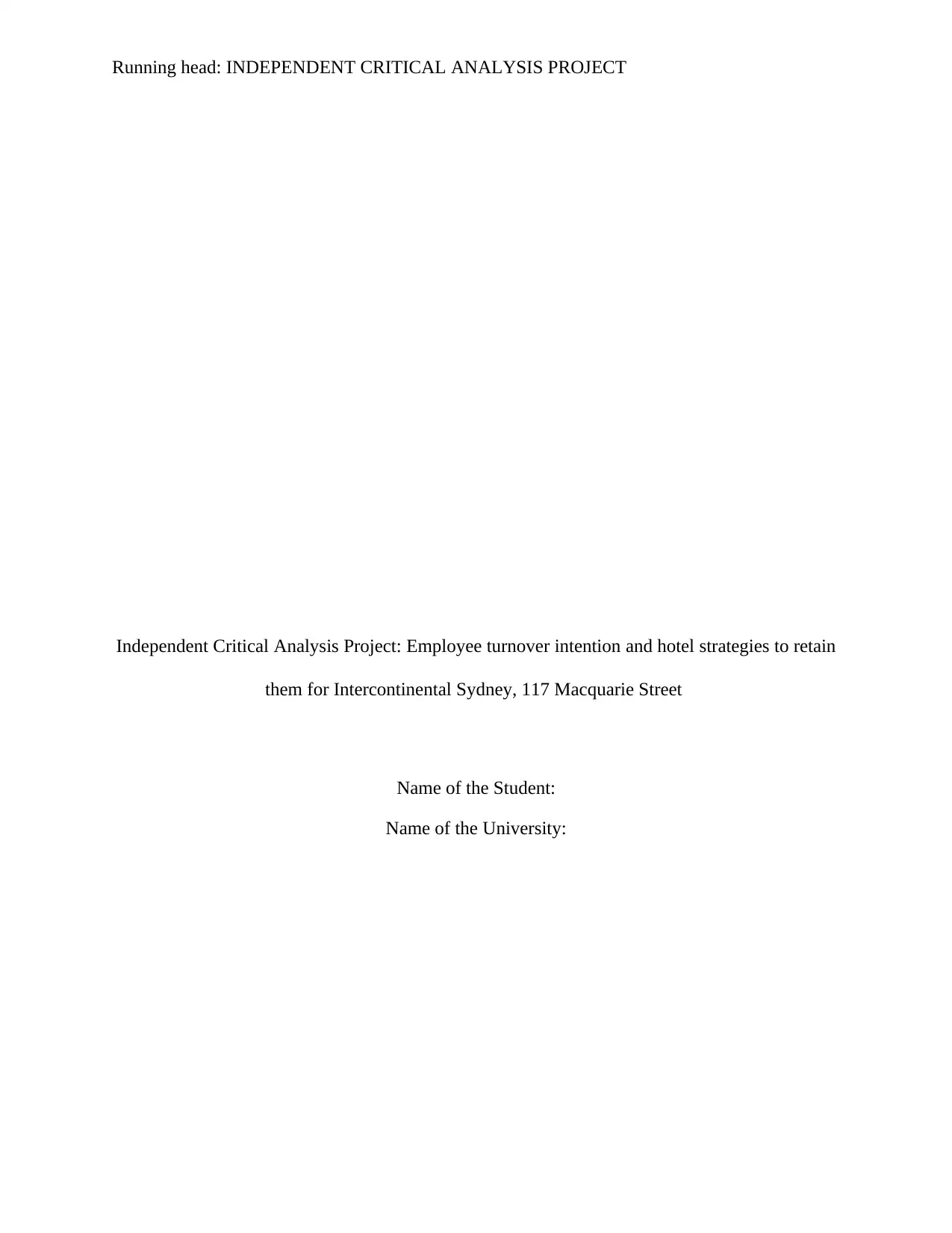
Running head: INDEPENDENT CRITICAL ANALYSIS PROJECT
Independent Critical Analysis Project: Employee turnover intention and hotel strategies to retain
them for Intercontinental Sydney, 117 Macquarie Street
Name of the Student:
Name of the University:
Independent Critical Analysis Project: Employee turnover intention and hotel strategies to retain
them for Intercontinental Sydney, 117 Macquarie Street
Name of the Student:
Name of the University:
Secure Best Marks with AI Grader
Need help grading? Try our AI Grader for instant feedback on your assignments.
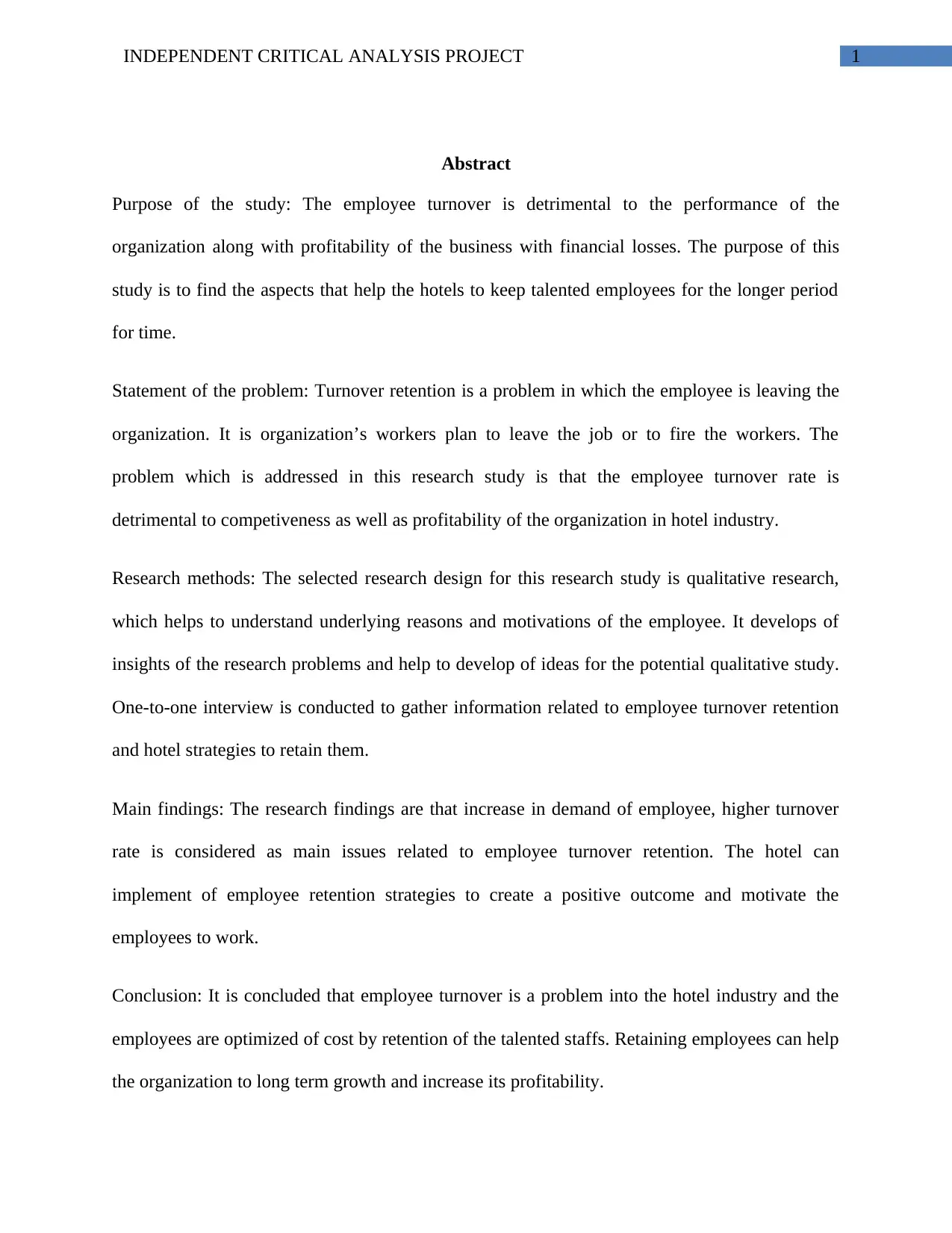
1INDEPENDENT CRITICAL ANALYSIS PROJECT
Abstract
Purpose of the study: The employee turnover is detrimental to the performance of the
organization along with profitability of the business with financial losses. The purpose of this
study is to find the aspects that help the hotels to keep talented employees for the longer period
for time.
Statement of the problem: Turnover retention is a problem in which the employee is leaving the
organization. It is organization’s workers plan to leave the job or to fire the workers. The
problem which is addressed in this research study is that the employee turnover rate is
detrimental to competiveness as well as profitability of the organization in hotel industry.
Research methods: The selected research design for this research study is qualitative research,
which helps to understand underlying reasons and motivations of the employee. It develops of
insights of the research problems and help to develop of ideas for the potential qualitative study.
One-to-one interview is conducted to gather information related to employee turnover retention
and hotel strategies to retain them.
Main findings: The research findings are that increase in demand of employee, higher turnover
rate is considered as main issues related to employee turnover retention. The hotel can
implement of employee retention strategies to create a positive outcome and motivate the
employees to work.
Conclusion: It is concluded that employee turnover is a problem into the hotel industry and the
employees are optimized of cost by retention of the talented staffs. Retaining employees can help
the organization to long term growth and increase its profitability.
Abstract
Purpose of the study: The employee turnover is detrimental to the performance of the
organization along with profitability of the business with financial losses. The purpose of this
study is to find the aspects that help the hotels to keep talented employees for the longer period
for time.
Statement of the problem: Turnover retention is a problem in which the employee is leaving the
organization. It is organization’s workers plan to leave the job or to fire the workers. The
problem which is addressed in this research study is that the employee turnover rate is
detrimental to competiveness as well as profitability of the organization in hotel industry.
Research methods: The selected research design for this research study is qualitative research,
which helps to understand underlying reasons and motivations of the employee. It develops of
insights of the research problems and help to develop of ideas for the potential qualitative study.
One-to-one interview is conducted to gather information related to employee turnover retention
and hotel strategies to retain them.
Main findings: The research findings are that increase in demand of employee, higher turnover
rate is considered as main issues related to employee turnover retention. The hotel can
implement of employee retention strategies to create a positive outcome and motivate the
employees to work.
Conclusion: It is concluded that employee turnover is a problem into the hotel industry and the
employees are optimized of cost by retention of the talented staffs. Retaining employees can help
the organization to long term growth and increase its profitability.
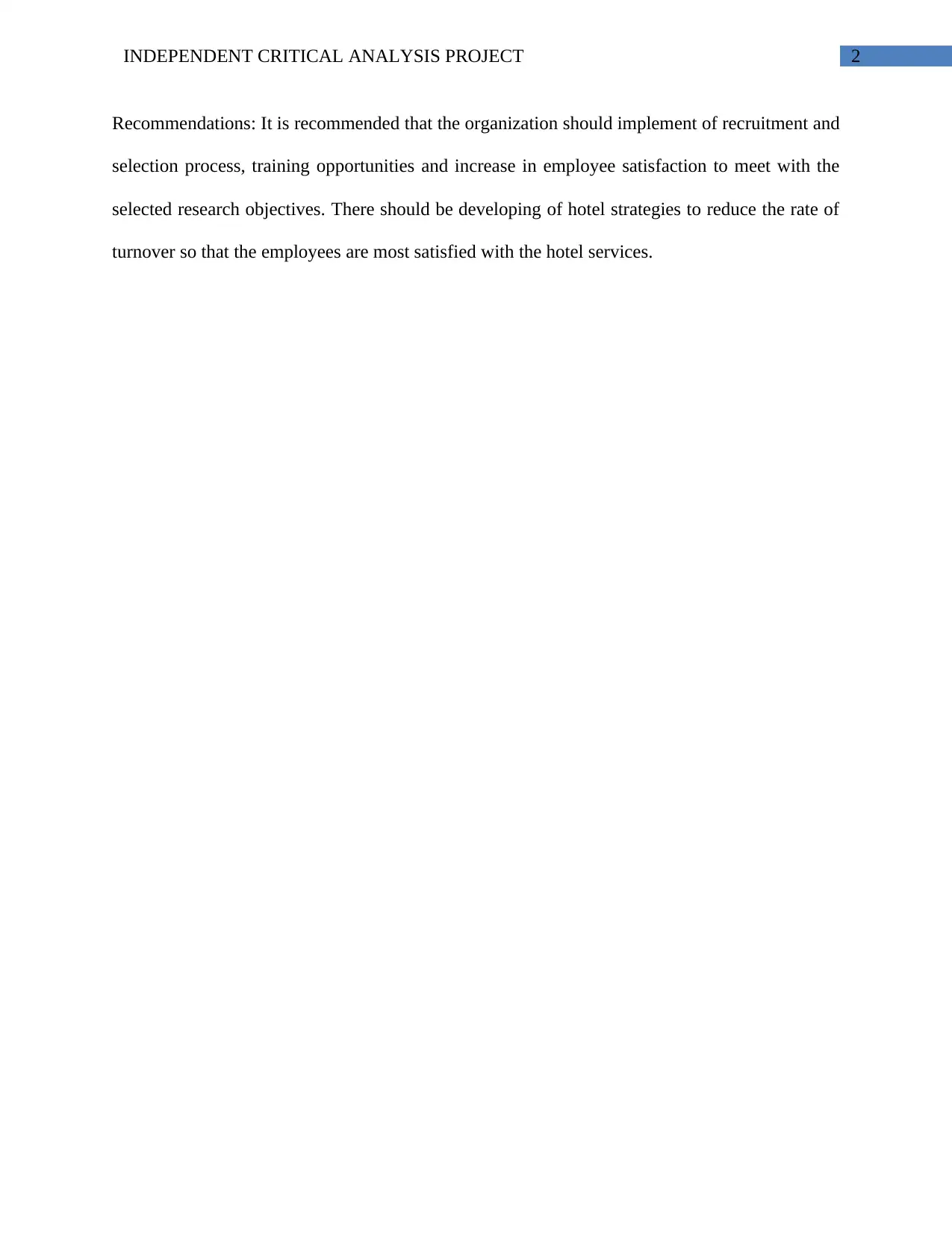
2INDEPENDENT CRITICAL ANALYSIS PROJECT
Recommendations: It is recommended that the organization should implement of recruitment and
selection process, training opportunities and increase in employee satisfaction to meet with the
selected research objectives. There should be developing of hotel strategies to reduce the rate of
turnover so that the employees are most satisfied with the hotel services.
Recommendations: It is recommended that the organization should implement of recruitment and
selection process, training opportunities and increase in employee satisfaction to meet with the
selected research objectives. There should be developing of hotel strategies to reduce the rate of
turnover so that the employees are most satisfied with the hotel services.
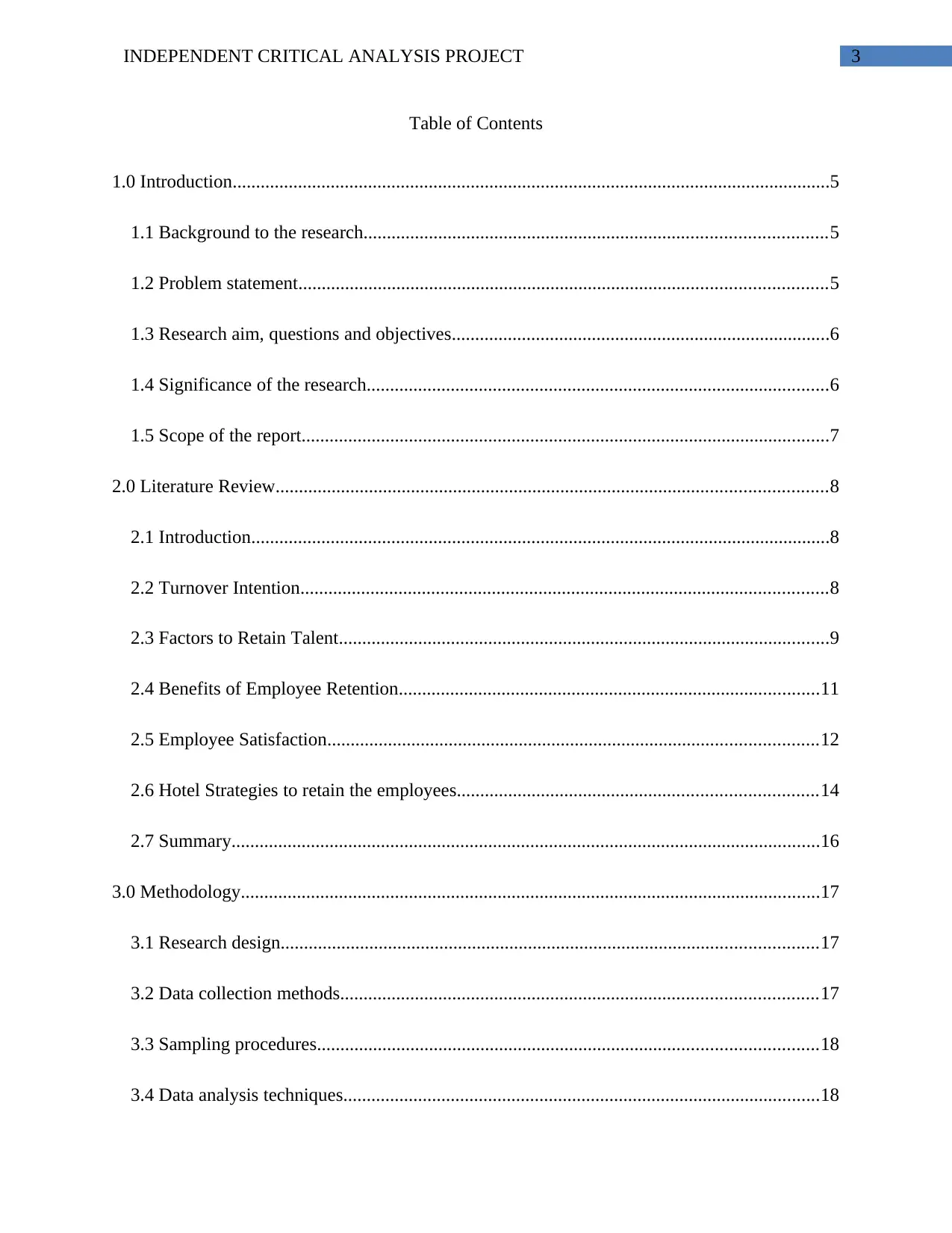
3INDEPENDENT CRITICAL ANALYSIS PROJECT
Table of Contents
1.0 Introduction................................................................................................................................5
1.1 Background to the research...................................................................................................5
1.2 Problem statement.................................................................................................................5
1.3 Research aim, questions and objectives.................................................................................6
1.4 Significance of the research...................................................................................................6
1.5 Scope of the report.................................................................................................................7
2.0 Literature Review......................................................................................................................8
2.1 Introduction............................................................................................................................8
2.2 Turnover Intention.................................................................................................................8
2.3 Factors to Retain Talent.........................................................................................................9
2.4 Benefits of Employee Retention..........................................................................................11
2.5 Employee Satisfaction.........................................................................................................12
2.6 Hotel Strategies to retain the employees.............................................................................14
2.7 Summary..............................................................................................................................16
3.0 Methodology............................................................................................................................17
3.1 Research design...................................................................................................................17
3.2 Data collection methods......................................................................................................17
3.3 Sampling procedures...........................................................................................................18
3.4 Data analysis techniques......................................................................................................18
Table of Contents
1.0 Introduction................................................................................................................................5
1.1 Background to the research...................................................................................................5
1.2 Problem statement.................................................................................................................5
1.3 Research aim, questions and objectives.................................................................................6
1.4 Significance of the research...................................................................................................6
1.5 Scope of the report.................................................................................................................7
2.0 Literature Review......................................................................................................................8
2.1 Introduction............................................................................................................................8
2.2 Turnover Intention.................................................................................................................8
2.3 Factors to Retain Talent.........................................................................................................9
2.4 Benefits of Employee Retention..........................................................................................11
2.5 Employee Satisfaction.........................................................................................................12
2.6 Hotel Strategies to retain the employees.............................................................................14
2.7 Summary..............................................................................................................................16
3.0 Methodology............................................................................................................................17
3.1 Research design...................................................................................................................17
3.2 Data collection methods......................................................................................................17
3.3 Sampling procedures...........................................................................................................18
3.4 Data analysis techniques......................................................................................................18
Secure Best Marks with AI Grader
Need help grading? Try our AI Grader for instant feedback on your assignments.
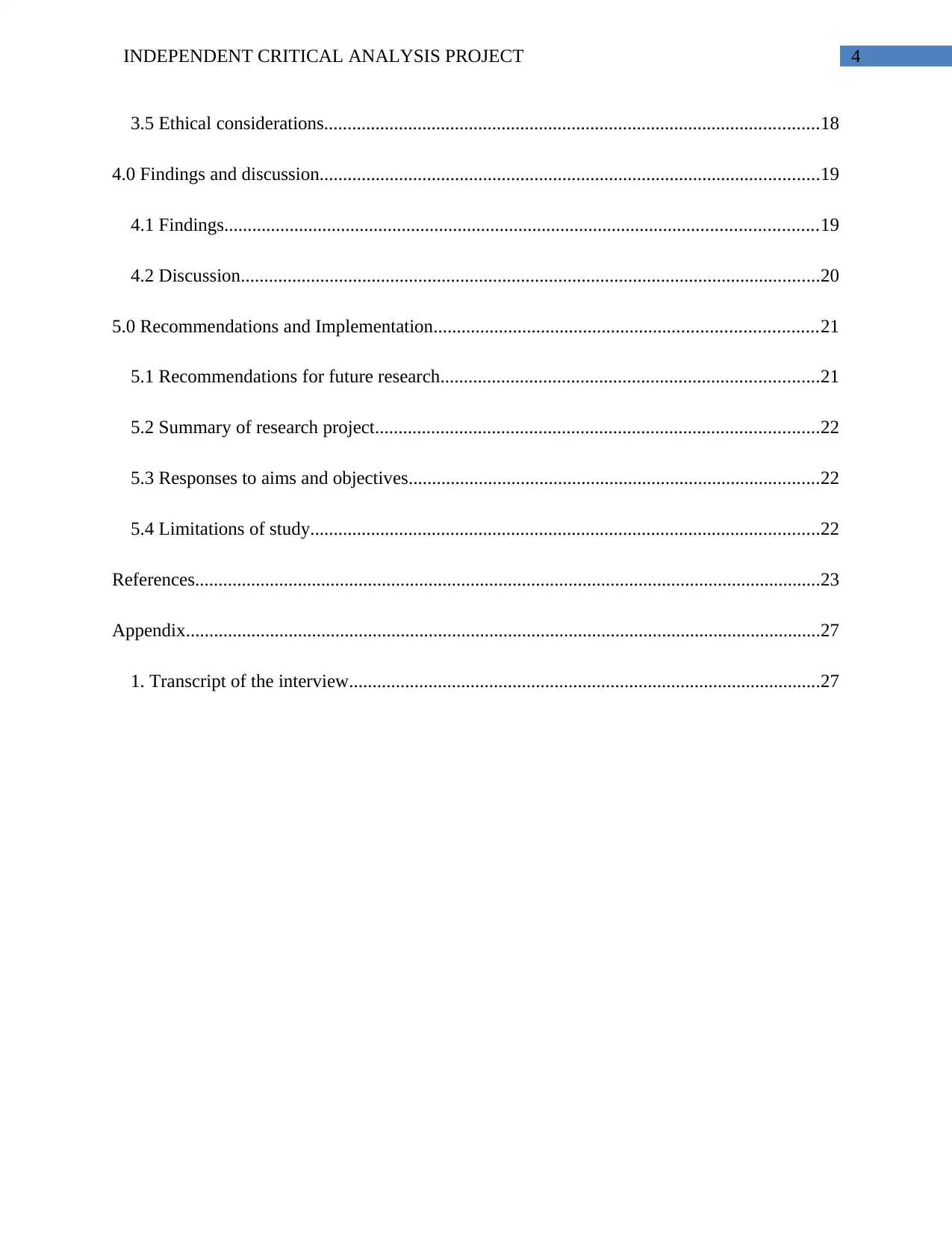
4INDEPENDENT CRITICAL ANALYSIS PROJECT
3.5 Ethical considerations..........................................................................................................18
4.0 Findings and discussion...........................................................................................................19
4.1 Findings...............................................................................................................................19
4.2 Discussion............................................................................................................................20
5.0 Recommendations and Implementation..................................................................................21
5.1 Recommendations for future research.................................................................................21
5.2 Summary of research project...............................................................................................22
5.3 Responses to aims and objectives........................................................................................22
5.4 Limitations of study.............................................................................................................22
References......................................................................................................................................23
Appendix........................................................................................................................................27
1. Transcript of the interview.....................................................................................................27
3.5 Ethical considerations..........................................................................................................18
4.0 Findings and discussion...........................................................................................................19
4.1 Findings...............................................................................................................................19
4.2 Discussion............................................................................................................................20
5.0 Recommendations and Implementation..................................................................................21
5.1 Recommendations for future research.................................................................................21
5.2 Summary of research project...............................................................................................22
5.3 Responses to aims and objectives........................................................................................22
5.4 Limitations of study.............................................................................................................22
References......................................................................................................................................23
Appendix........................................................................................................................................27
1. Transcript of the interview.....................................................................................................27
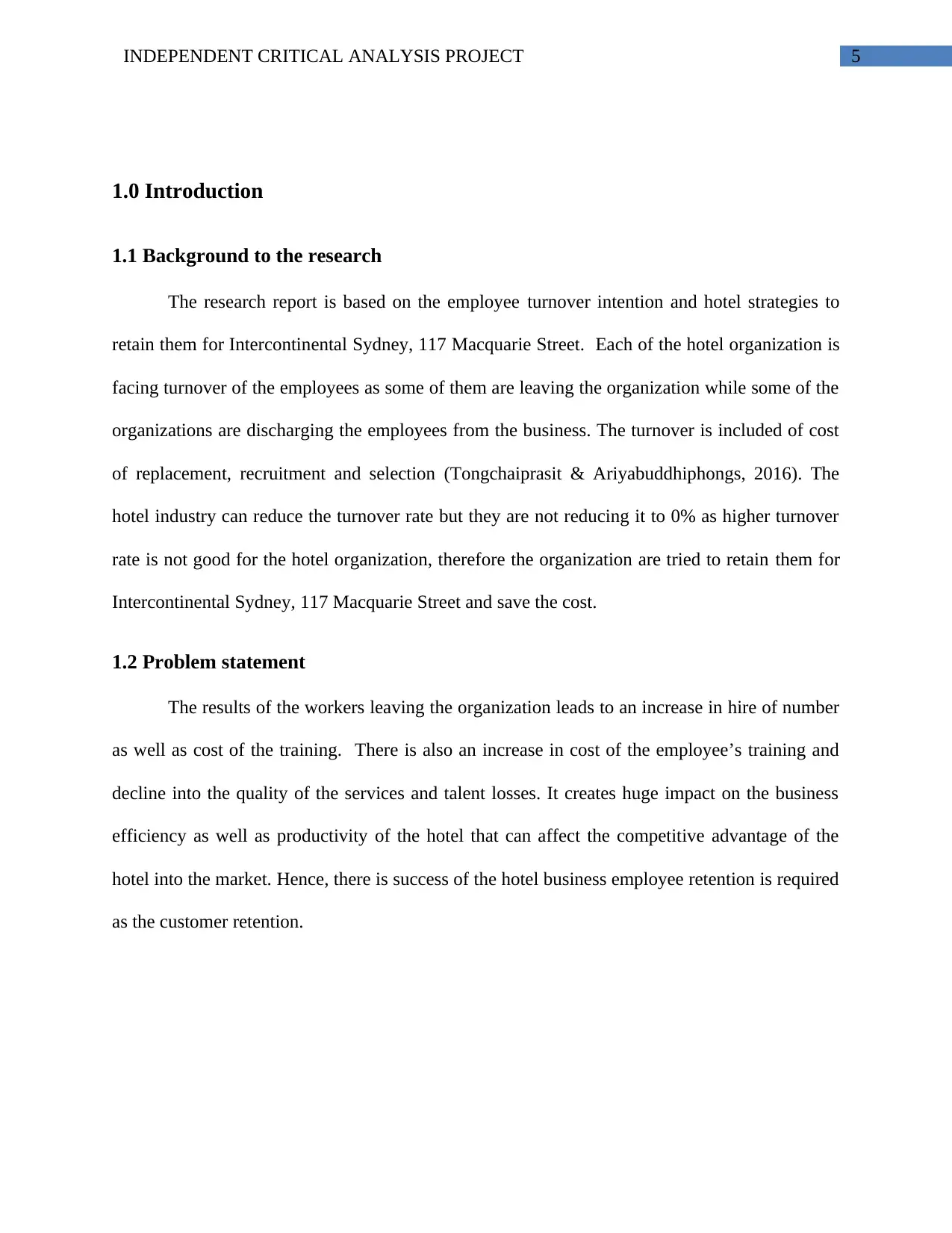
5INDEPENDENT CRITICAL ANALYSIS PROJECT
1.0 Introduction
1.1 Background to the research
The research report is based on the employee turnover intention and hotel strategies to
retain them for Intercontinental Sydney, 117 Macquarie Street. Each of the hotel organization is
facing turnover of the employees as some of them are leaving the organization while some of the
organizations are discharging the employees from the business. The turnover is included of cost
of replacement, recruitment and selection (Tongchaiprasit & Ariyabuddhiphongs, 2016). The
hotel industry can reduce the turnover rate but they are not reducing it to 0% as higher turnover
rate is not good for the hotel organization, therefore the organization are tried to retain them for
Intercontinental Sydney, 117 Macquarie Street and save the cost.
1.2 Problem statement
The results of the workers leaving the organization leads to an increase in hire of number
as well as cost of the training. There is also an increase in cost of the employee’s training and
decline into the quality of the services and talent losses. It creates huge impact on the business
efficiency as well as productivity of the hotel that can affect the competitive advantage of the
hotel into the market. Hence, there is success of the hotel business employee retention is required
as the customer retention.
1.0 Introduction
1.1 Background to the research
The research report is based on the employee turnover intention and hotel strategies to
retain them for Intercontinental Sydney, 117 Macquarie Street. Each of the hotel organization is
facing turnover of the employees as some of them are leaving the organization while some of the
organizations are discharging the employees from the business. The turnover is included of cost
of replacement, recruitment and selection (Tongchaiprasit & Ariyabuddhiphongs, 2016). The
hotel industry can reduce the turnover rate but they are not reducing it to 0% as higher turnover
rate is not good for the hotel organization, therefore the organization are tried to retain them for
Intercontinental Sydney, 117 Macquarie Street and save the cost.
1.2 Problem statement
The results of the workers leaving the organization leads to an increase in hire of number
as well as cost of the training. There is also an increase in cost of the employee’s training and
decline into the quality of the services and talent losses. It creates huge impact on the business
efficiency as well as productivity of the hotel that can affect the competitive advantage of the
hotel into the market. Hence, there is success of the hotel business employee retention is required
as the customer retention.
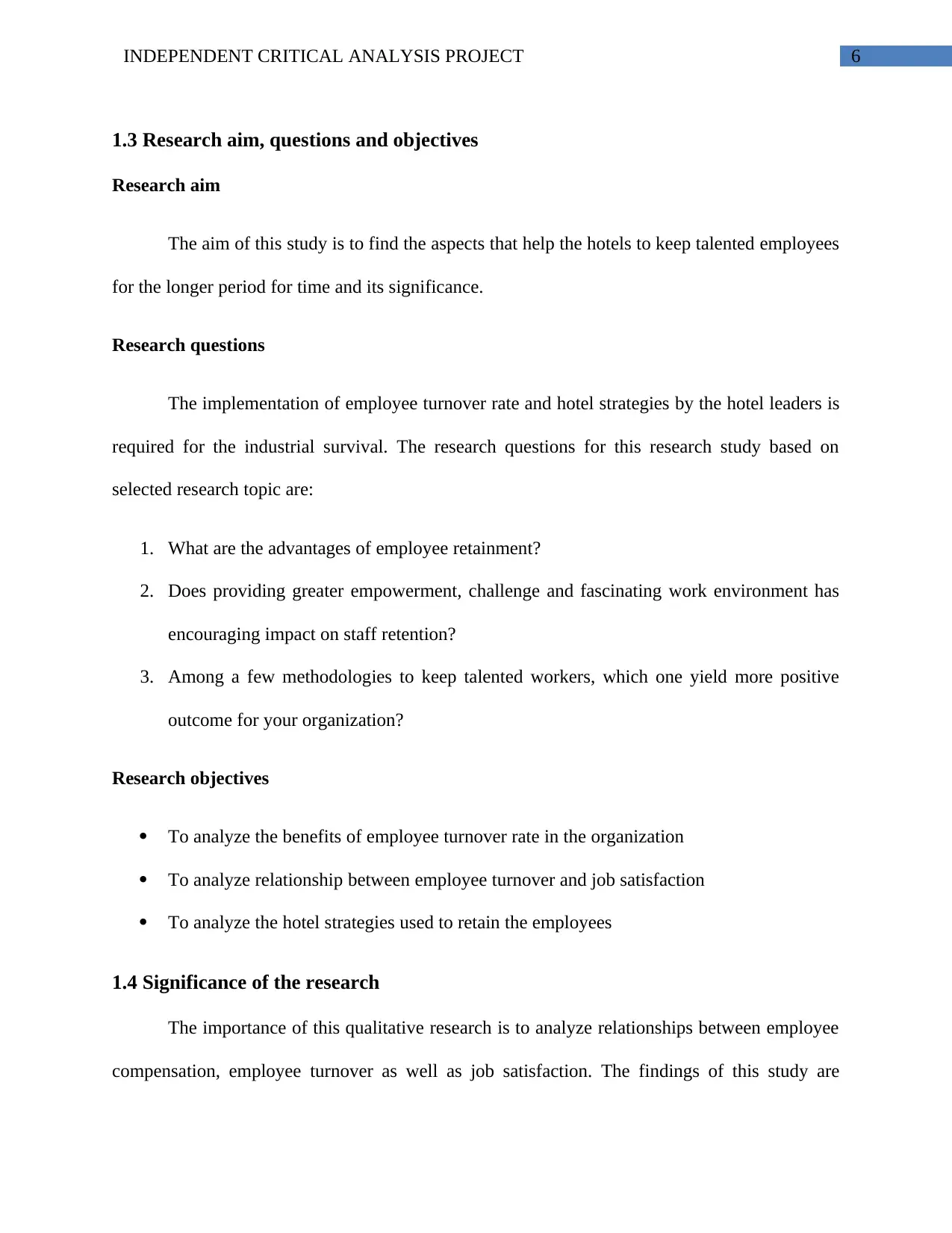
6INDEPENDENT CRITICAL ANALYSIS PROJECT
1.3 Research aim, questions and objectives
Research aim
The aim of this study is to find the aspects that help the hotels to keep talented employees
for the longer period for time and its significance.
Research questions
The implementation of employee turnover rate and hotel strategies by the hotel leaders is
required for the industrial survival. The research questions for this research study based on
selected research topic are:
1. What are the advantages of employee retainment?
2. Does providing greater empowerment, challenge and fascinating work environment has
encouraging impact on staff retention?
3. Among a few methodologies to keep talented workers, which one yield more positive
outcome for your organization?
Research objectives
To analyze the benefits of employee turnover rate in the organization
To analyze relationship between employee turnover and job satisfaction
To analyze the hotel strategies used to retain the employees
1.4 Significance of the research
The importance of this qualitative research is to analyze relationships between employee
compensation, employee turnover as well as job satisfaction. The findings of this study are
1.3 Research aim, questions and objectives
Research aim
The aim of this study is to find the aspects that help the hotels to keep talented employees
for the longer period for time and its significance.
Research questions
The implementation of employee turnover rate and hotel strategies by the hotel leaders is
required for the industrial survival. The research questions for this research study based on
selected research topic are:
1. What are the advantages of employee retainment?
2. Does providing greater empowerment, challenge and fascinating work environment has
encouraging impact on staff retention?
3. Among a few methodologies to keep talented workers, which one yield more positive
outcome for your organization?
Research objectives
To analyze the benefits of employee turnover rate in the organization
To analyze relationship between employee turnover and job satisfaction
To analyze the hotel strategies used to retain the employees
1.4 Significance of the research
The importance of this qualitative research is to analyze relationships between employee
compensation, employee turnover as well as job satisfaction. The findings of this study are
Paraphrase This Document
Need a fresh take? Get an instant paraphrase of this document with our AI Paraphraser
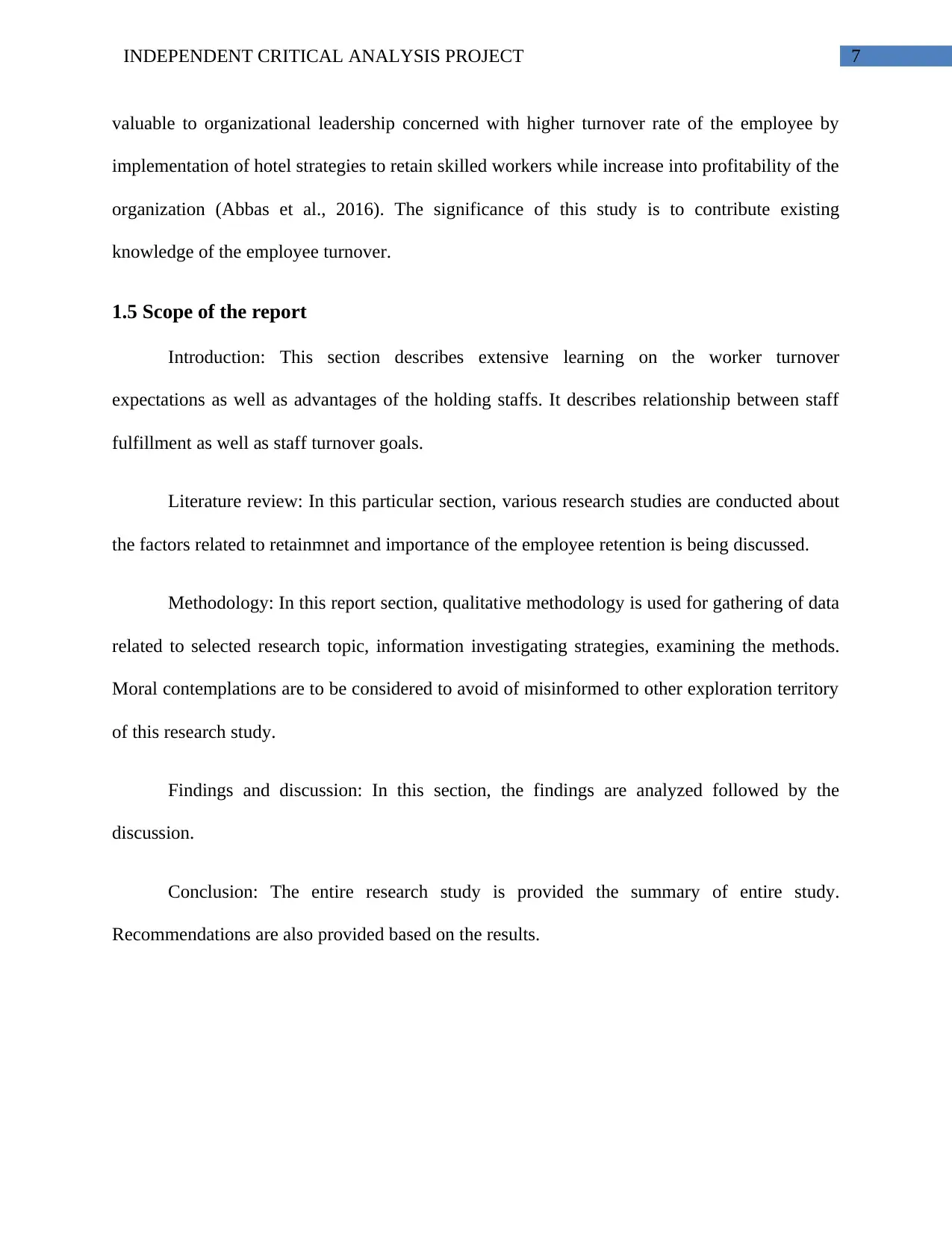
7INDEPENDENT CRITICAL ANALYSIS PROJECT
valuable to organizational leadership concerned with higher turnover rate of the employee by
implementation of hotel strategies to retain skilled workers while increase into profitability of the
organization (Abbas et al., 2016). The significance of this study is to contribute existing
knowledge of the employee turnover.
1.5 Scope of the report
Introduction: This section describes extensive learning on the worker turnover
expectations as well as advantages of the holding staffs. It describes relationship between staff
fulfillment as well as staff turnover goals.
Literature review: In this particular section, various research studies are conducted about
the factors related to retainmnet and importance of the employee retention is being discussed.
Methodology: In this report section, qualitative methodology is used for gathering of data
related to selected research topic, information investigating strategies, examining the methods.
Moral contemplations are to be considered to avoid of misinformed to other exploration territory
of this research study.
Findings and discussion: In this section, the findings are analyzed followed by the
discussion.
Conclusion: The entire research study is provided the summary of entire study.
Recommendations are also provided based on the results.
valuable to organizational leadership concerned with higher turnover rate of the employee by
implementation of hotel strategies to retain skilled workers while increase into profitability of the
organization (Abbas et al., 2016). The significance of this study is to contribute existing
knowledge of the employee turnover.
1.5 Scope of the report
Introduction: This section describes extensive learning on the worker turnover
expectations as well as advantages of the holding staffs. It describes relationship between staff
fulfillment as well as staff turnover goals.
Literature review: In this particular section, various research studies are conducted about
the factors related to retainmnet and importance of the employee retention is being discussed.
Methodology: In this report section, qualitative methodology is used for gathering of data
related to selected research topic, information investigating strategies, examining the methods.
Moral contemplations are to be considered to avoid of misinformed to other exploration territory
of this research study.
Findings and discussion: In this section, the findings are analyzed followed by the
discussion.
Conclusion: The entire research study is provided the summary of entire study.
Recommendations are also provided based on the results.
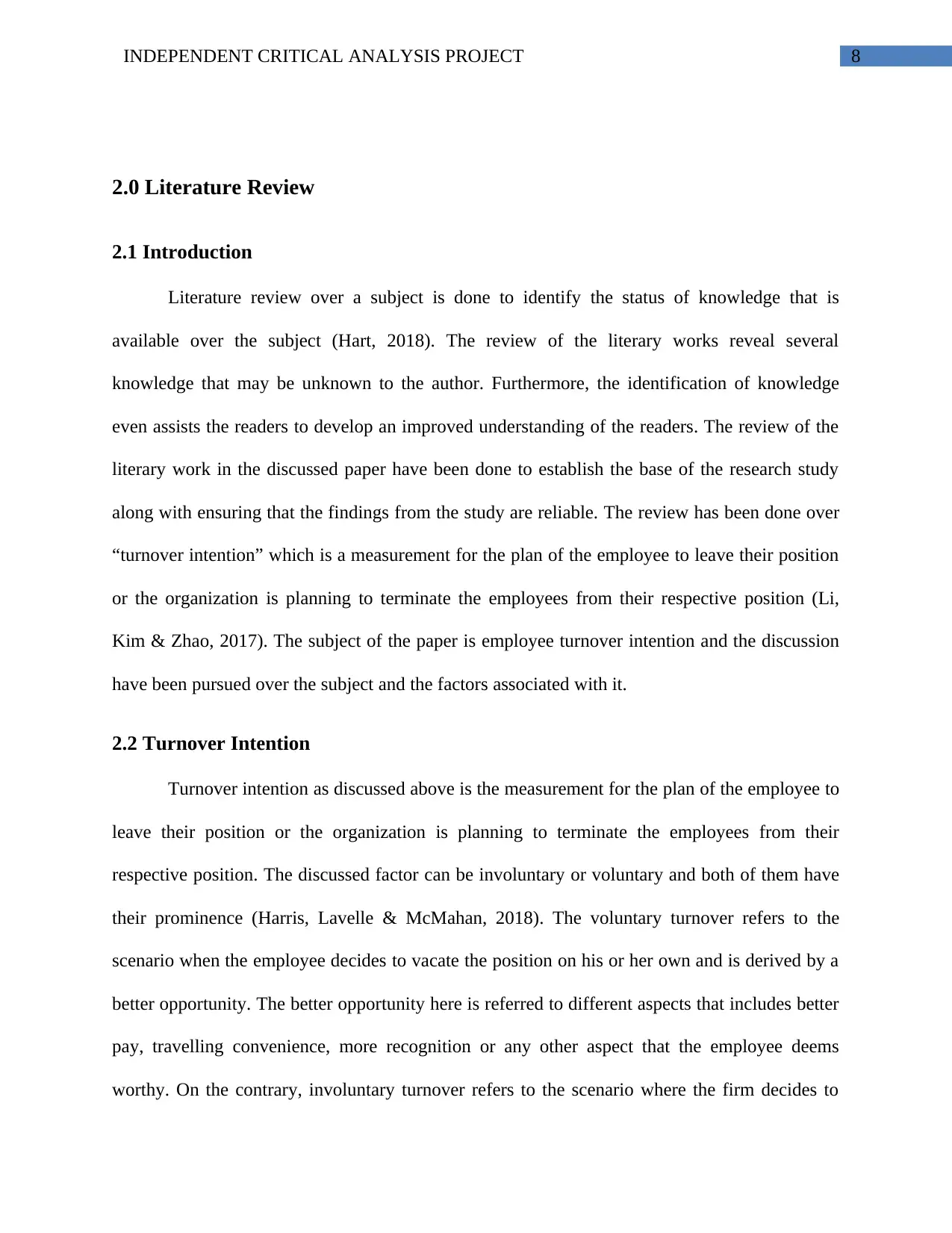
8INDEPENDENT CRITICAL ANALYSIS PROJECT
2.0 Literature Review
2.1 Introduction
Literature review over a subject is done to identify the status of knowledge that is
available over the subject (Hart, 2018). The review of the literary works reveal several
knowledge that may be unknown to the author. Furthermore, the identification of knowledge
even assists the readers to develop an improved understanding of the readers. The review of the
literary work in the discussed paper have been done to establish the base of the research study
along with ensuring that the findings from the study are reliable. The review has been done over
“turnover intention” which is a measurement for the plan of the employee to leave their position
or the organization is planning to terminate the employees from their respective position (Li,
Kim & Zhao, 2017). The subject of the paper is employee turnover intention and the discussion
have been pursued over the subject and the factors associated with it.
2.2 Turnover Intention
Turnover intention as discussed above is the measurement for the plan of the employee to
leave their position or the organization is planning to terminate the employees from their
respective position. The discussed factor can be involuntary or voluntary and both of them have
their prominence (Harris, Lavelle & McMahan, 2018). The voluntary turnover refers to the
scenario when the employee decides to vacate the position on his or her own and is derived by a
better opportunity. The better opportunity here is referred to different aspects that includes better
pay, travelling convenience, more recognition or any other aspect that the employee deems
worthy. On the contrary, involuntary turnover refers to the scenario where the firm decides to
2.0 Literature Review
2.1 Introduction
Literature review over a subject is done to identify the status of knowledge that is
available over the subject (Hart, 2018). The review of the literary works reveal several
knowledge that may be unknown to the author. Furthermore, the identification of knowledge
even assists the readers to develop an improved understanding of the readers. The review of the
literary work in the discussed paper have been done to establish the base of the research study
along with ensuring that the findings from the study are reliable. The review has been done over
“turnover intention” which is a measurement for the plan of the employee to leave their position
or the organization is planning to terminate the employees from their respective position (Li,
Kim & Zhao, 2017). The subject of the paper is employee turnover intention and the discussion
have been pursued over the subject and the factors associated with it.
2.2 Turnover Intention
Turnover intention as discussed above is the measurement for the plan of the employee to
leave their position or the organization is planning to terminate the employees from their
respective position. The discussed factor can be involuntary or voluntary and both of them have
their prominence (Harris, Lavelle & McMahan, 2018). The voluntary turnover refers to the
scenario when the employee decides to vacate the position on his or her own and is derived by a
better opportunity. The better opportunity here is referred to different aspects that includes better
pay, travelling convenience, more recognition or any other aspect that the employee deems
worthy. On the contrary, involuntary turnover refers to the scenario where the firm decides to
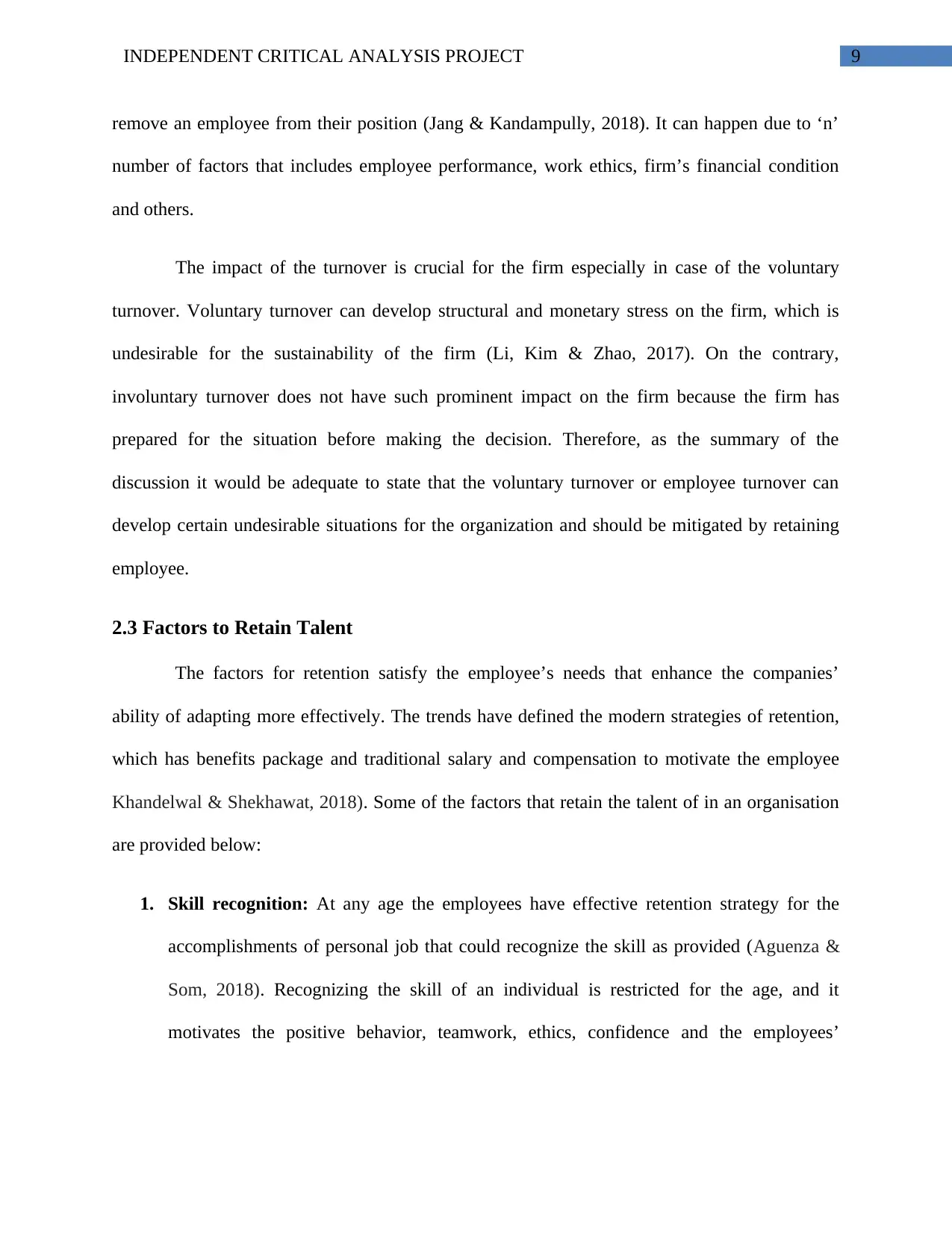
9INDEPENDENT CRITICAL ANALYSIS PROJECT
remove an employee from their position (Jang & Kandampully, 2018). It can happen due to ‘n’
number of factors that includes employee performance, work ethics, firm’s financial condition
and others.
The impact of the turnover is crucial for the firm especially in case of the voluntary
turnover. Voluntary turnover can develop structural and monetary stress on the firm, which is
undesirable for the sustainability of the firm (Li, Kim & Zhao, 2017). On the contrary,
involuntary turnover does not have such prominent impact on the firm because the firm has
prepared for the situation before making the decision. Therefore, as the summary of the
discussion it would be adequate to state that the voluntary turnover or employee turnover can
develop certain undesirable situations for the organization and should be mitigated by retaining
employee.
2.3 Factors to Retain Talent
The factors for retention satisfy the employee’s needs that enhance the companies’
ability of adapting more effectively. The trends have defined the modern strategies of retention,
which has benefits package and traditional salary and compensation to motivate the employee
Khandelwal & Shekhawat, 2018). Some of the factors that retain the talent of in an organisation
are provided below:
1. Skill recognition: At any age the employees have effective retention strategy for the
accomplishments of personal job that could recognize the skill as provided (Aguenza &
Som, 2018). Recognizing the skill of an individual is restricted for the age, and it
motivates the positive behavior, teamwork, ethics, confidence and the employees’
remove an employee from their position (Jang & Kandampully, 2018). It can happen due to ‘n’
number of factors that includes employee performance, work ethics, firm’s financial condition
and others.
The impact of the turnover is crucial for the firm especially in case of the voluntary
turnover. Voluntary turnover can develop structural and monetary stress on the firm, which is
undesirable for the sustainability of the firm (Li, Kim & Zhao, 2017). On the contrary,
involuntary turnover does not have such prominent impact on the firm because the firm has
prepared for the situation before making the decision. Therefore, as the summary of the
discussion it would be adequate to state that the voluntary turnover or employee turnover can
develop certain undesirable situations for the organization and should be mitigated by retaining
employee.
2.3 Factors to Retain Talent
The factors for retention satisfy the employee’s needs that enhance the companies’
ability of adapting more effectively. The trends have defined the modern strategies of retention,
which has benefits package and traditional salary and compensation to motivate the employee
Khandelwal & Shekhawat, 2018). Some of the factors that retain the talent of in an organisation
are provided below:
1. Skill recognition: At any age the employees have effective retention strategy for the
accomplishments of personal job that could recognize the skill as provided (Aguenza &
Som, 2018). Recognizing the skill of an individual is restricted for the age, and it
motivates the positive behavior, teamwork, ethics, confidence and the employees’
Secure Best Marks with AI Grader
Need help grading? Try our AI Grader for instant feedback on your assignments.
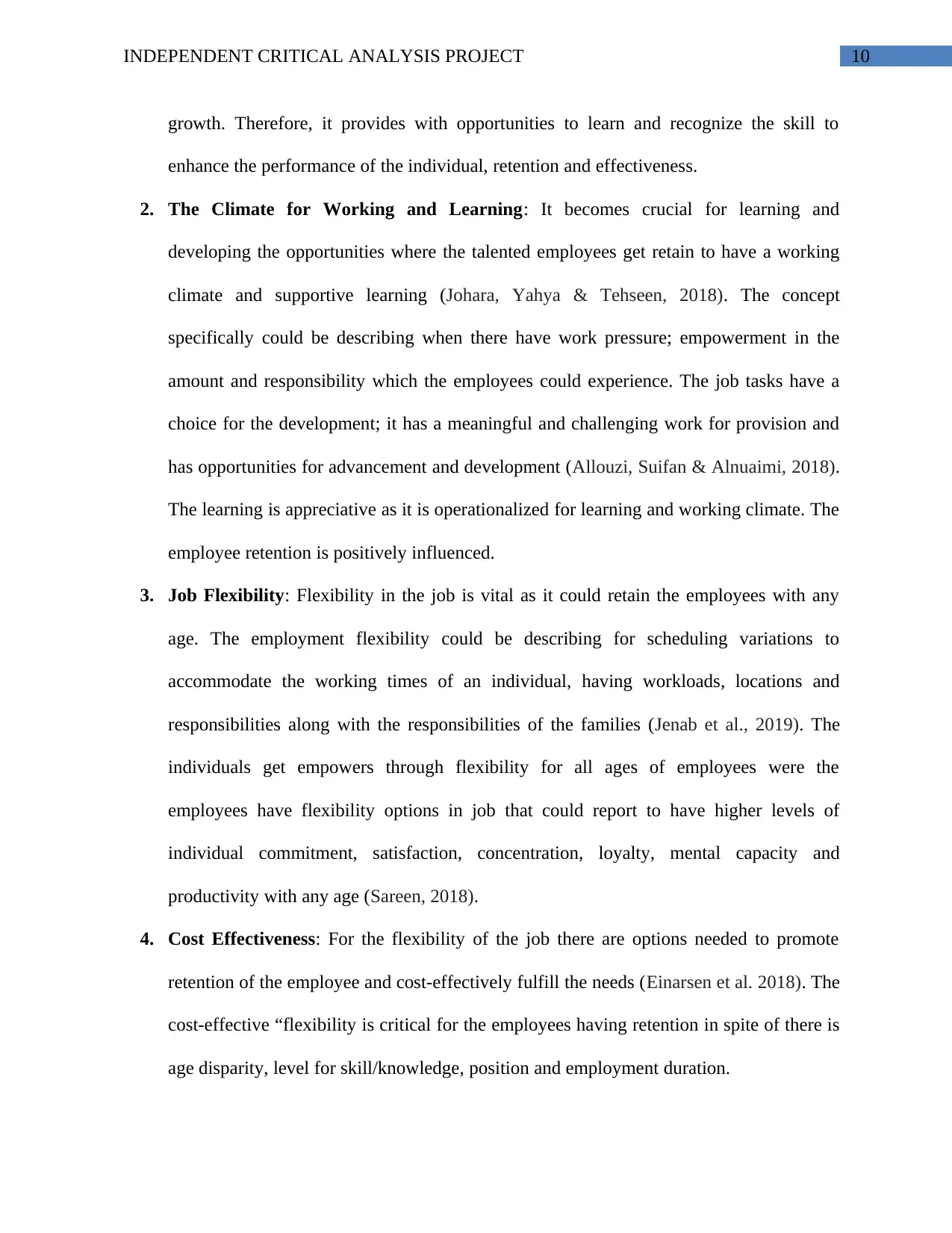
10INDEPENDENT CRITICAL ANALYSIS PROJECT
growth. Therefore, it provides with opportunities to learn and recognize the skill to
enhance the performance of the individual, retention and effectiveness.
2. The Climate for Working and Learning: It becomes crucial for learning and
developing the opportunities where the talented employees get retain to have a working
climate and supportive learning (Johara, Yahya & Tehseen, 2018). The concept
specifically could be describing when there have work pressure; empowerment in the
amount and responsibility which the employees could experience. The job tasks have a
choice for the development; it has a meaningful and challenging work for provision and
has opportunities for advancement and development (Allouzi, Suifan & Alnuaimi, 2018).
The learning is appreciative as it is operationalized for learning and working climate. The
employee retention is positively influenced.
3. Job Flexibility: Flexibility in the job is vital as it could retain the employees with any
age. The employment flexibility could be describing for scheduling variations to
accommodate the working times of an individual, having workloads, locations and
responsibilities along with the responsibilities of the families (Jenab et al., 2019). The
individuals get empowers through flexibility for all ages of employees were the
employees have flexibility options in job that could report to have higher levels of
individual commitment, satisfaction, concentration, loyalty, mental capacity and
productivity with any age (Sareen, 2018).
4. Cost Effectiveness: For the flexibility of the job there are options needed to promote
retention of the employee and cost-effectively fulfill the needs (Einarsen et al. 2018). The
cost-effective “flexibility is critical for the employees having retention in spite of there is
age disparity, level for skill/knowledge, position and employment duration.
growth. Therefore, it provides with opportunities to learn and recognize the skill to
enhance the performance of the individual, retention and effectiveness.
2. The Climate for Working and Learning: It becomes crucial for learning and
developing the opportunities where the talented employees get retain to have a working
climate and supportive learning (Johara, Yahya & Tehseen, 2018). The concept
specifically could be describing when there have work pressure; empowerment in the
amount and responsibility which the employees could experience. The job tasks have a
choice for the development; it has a meaningful and challenging work for provision and
has opportunities for advancement and development (Allouzi, Suifan & Alnuaimi, 2018).
The learning is appreciative as it is operationalized for learning and working climate. The
employee retention is positively influenced.
3. Job Flexibility: Flexibility in the job is vital as it could retain the employees with any
age. The employment flexibility could be describing for scheduling variations to
accommodate the working times of an individual, having workloads, locations and
responsibilities along with the responsibilities of the families (Jenab et al., 2019). The
individuals get empowers through flexibility for all ages of employees were the
employees have flexibility options in job that could report to have higher levels of
individual commitment, satisfaction, concentration, loyalty, mental capacity and
productivity with any age (Sareen, 2018).
4. Cost Effectiveness: For the flexibility of the job there are options needed to promote
retention of the employee and cost-effectively fulfill the needs (Einarsen et al. 2018). The
cost-effective “flexibility is critical for the employees having retention in spite of there is
age disparity, level for skill/knowledge, position and employment duration.
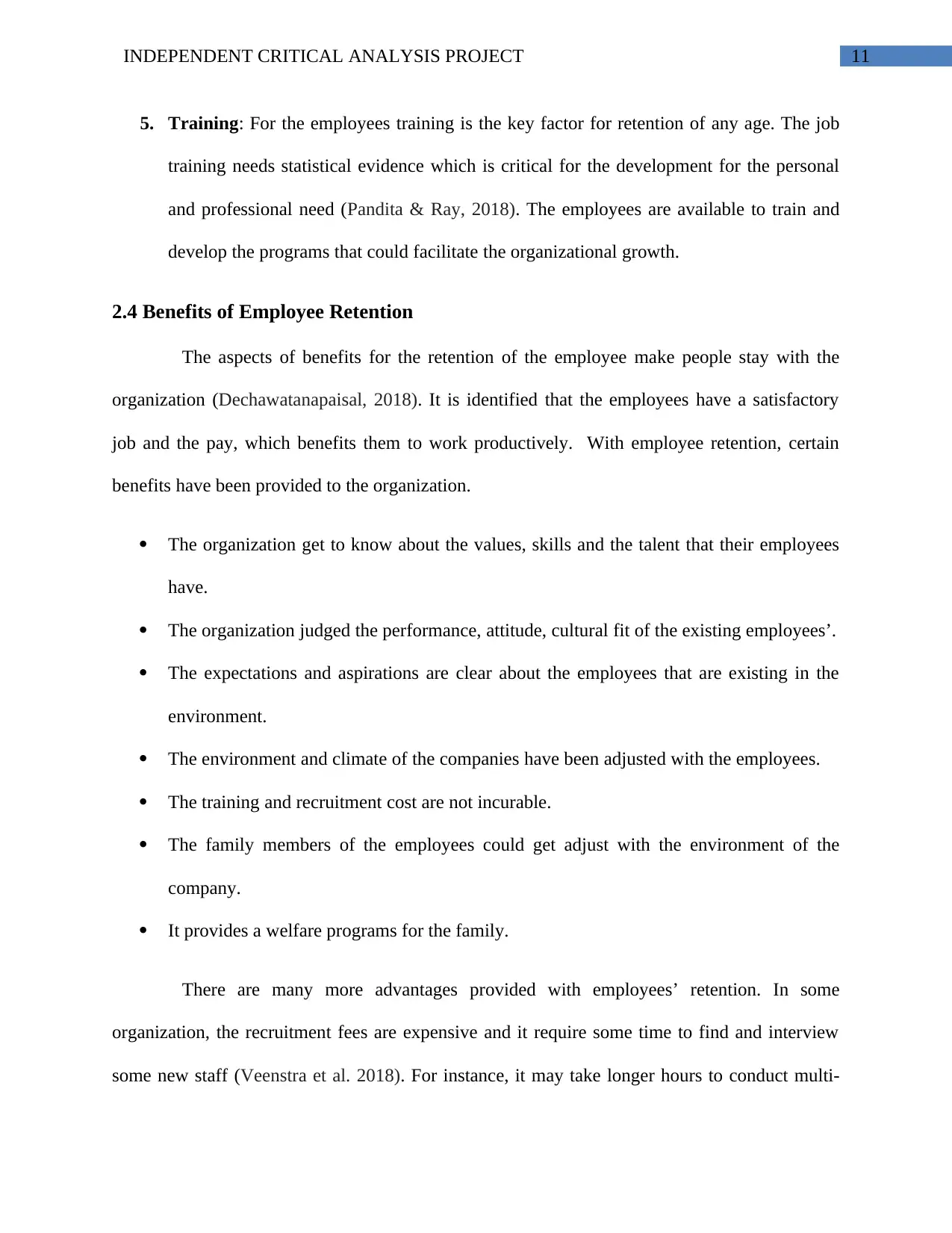
11INDEPENDENT CRITICAL ANALYSIS PROJECT
5. Training: For the employees training is the key factor for retention of any age. The job
training needs statistical evidence which is critical for the development for the personal
and professional need (Pandita & Ray, 2018). The employees are available to train and
develop the programs that could facilitate the organizational growth.
2.4 Benefits of Employee Retention
The aspects of benefits for the retention of the employee make people stay with the
organization (Dechawatanapaisal, 2018). It is identified that the employees have a satisfactory
job and the pay, which benefits them to work productively. With employee retention, certain
benefits have been provided to the organization.
The organization get to know about the values, skills and the talent that their employees
have.
The organization judged the performance, attitude, cultural fit of the existing employees’.
The expectations and aspirations are clear about the employees that are existing in the
environment.
The environment and climate of the companies have been adjusted with the employees.
The training and recruitment cost are not incurable.
The family members of the employees could get adjust with the environment of the
company.
It provides a welfare programs for the family.
There are many more advantages provided with employees’ retention. In some
organization, the recruitment fees are expensive and it require some time to find and interview
some new staff (Veenstra et al. 2018). For instance, it may take longer hours to conduct multi-
5. Training: For the employees training is the key factor for retention of any age. The job
training needs statistical evidence which is critical for the development for the personal
and professional need (Pandita & Ray, 2018). The employees are available to train and
develop the programs that could facilitate the organizational growth.
2.4 Benefits of Employee Retention
The aspects of benefits for the retention of the employee make people stay with the
organization (Dechawatanapaisal, 2018). It is identified that the employees have a satisfactory
job and the pay, which benefits them to work productively. With employee retention, certain
benefits have been provided to the organization.
The organization get to know about the values, skills and the talent that their employees
have.
The organization judged the performance, attitude, cultural fit of the existing employees’.
The expectations and aspirations are clear about the employees that are existing in the
environment.
The environment and climate of the companies have been adjusted with the employees.
The training and recruitment cost are not incurable.
The family members of the employees could get adjust with the environment of the
company.
It provides a welfare programs for the family.
There are many more advantages provided with employees’ retention. In some
organization, the recruitment fees are expensive and it require some time to find and interview
some new staff (Veenstra et al. 2018). For instance, it may take longer hours to conduct multi-
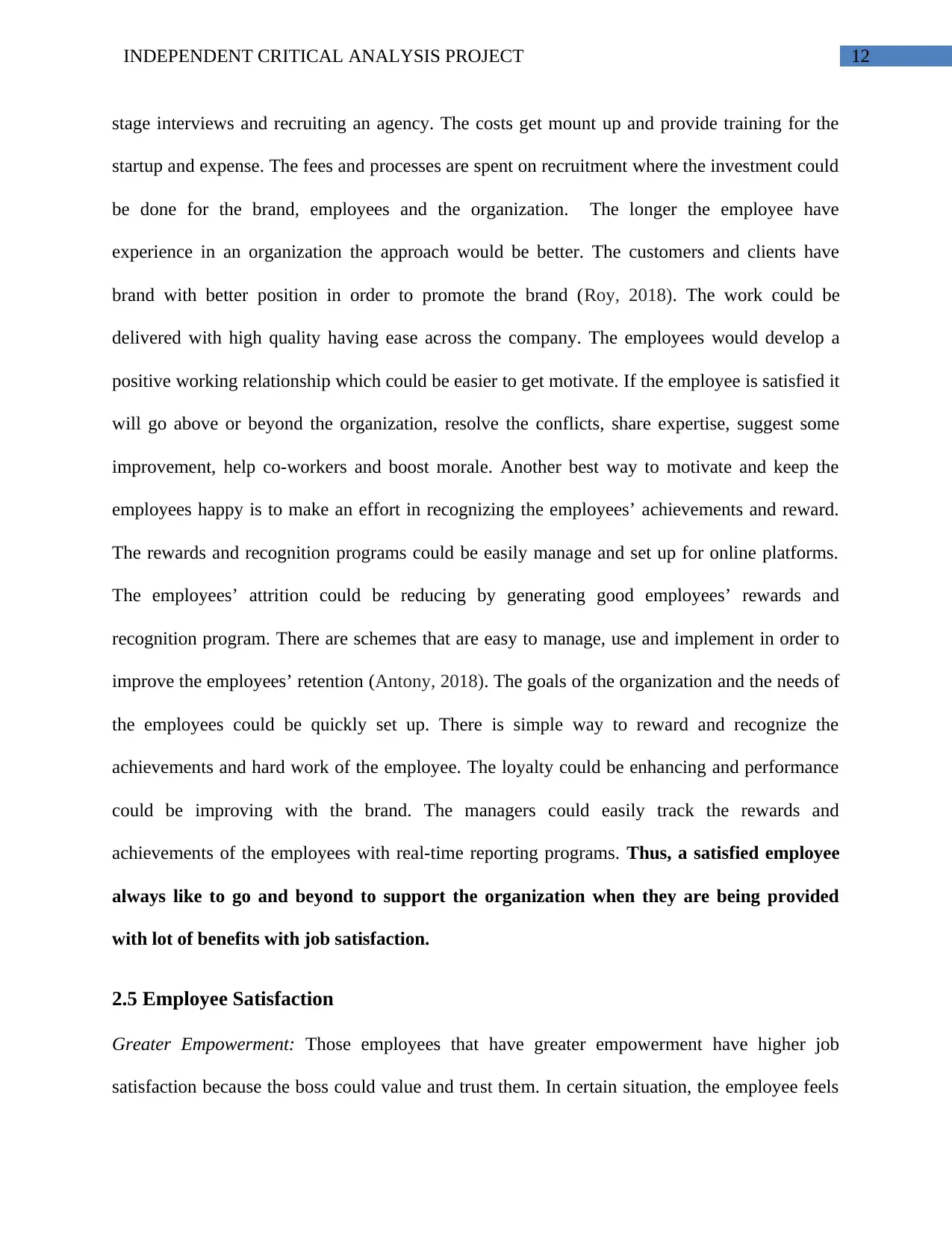
12INDEPENDENT CRITICAL ANALYSIS PROJECT
stage interviews and recruiting an agency. The costs get mount up and provide training for the
startup and expense. The fees and processes are spent on recruitment where the investment could
be done for the brand, employees and the organization. The longer the employee have
experience in an organization the approach would be better. The customers and clients have
brand with better position in order to promote the brand (Roy, 2018). The work could be
delivered with high quality having ease across the company. The employees would develop a
positive working relationship which could be easier to get motivate. If the employee is satisfied it
will go above or beyond the organization, resolve the conflicts, share expertise, suggest some
improvement, help co-workers and boost morale. Another best way to motivate and keep the
employees happy is to make an effort in recognizing the employees’ achievements and reward.
The rewards and recognition programs could be easily manage and set up for online platforms.
The employees’ attrition could be reducing by generating good employees’ rewards and
recognition program. There are schemes that are easy to manage, use and implement in order to
improve the employees’ retention (Antony, 2018). The goals of the organization and the needs of
the employees could be quickly set up. There is simple way to reward and recognize the
achievements and hard work of the employee. The loyalty could be enhancing and performance
could be improving with the brand. The managers could easily track the rewards and
achievements of the employees with real-time reporting programs. Thus, a satisfied employee
always like to go and beyond to support the organization when they are being provided
with lot of benefits with job satisfaction.
2.5 Employee Satisfaction
Greater Empowerment: Those employees that have greater empowerment have higher job
satisfaction because the boss could value and trust them. In certain situation, the employee feels
stage interviews and recruiting an agency. The costs get mount up and provide training for the
startup and expense. The fees and processes are spent on recruitment where the investment could
be done for the brand, employees and the organization. The longer the employee have
experience in an organization the approach would be better. The customers and clients have
brand with better position in order to promote the brand (Roy, 2018). The work could be
delivered with high quality having ease across the company. The employees would develop a
positive working relationship which could be easier to get motivate. If the employee is satisfied it
will go above or beyond the organization, resolve the conflicts, share expertise, suggest some
improvement, help co-workers and boost morale. Another best way to motivate and keep the
employees happy is to make an effort in recognizing the employees’ achievements and reward.
The rewards and recognition programs could be easily manage and set up for online platforms.
The employees’ attrition could be reducing by generating good employees’ rewards and
recognition program. There are schemes that are easy to manage, use and implement in order to
improve the employees’ retention (Antony, 2018). The goals of the organization and the needs of
the employees could be quickly set up. There is simple way to reward and recognize the
achievements and hard work of the employee. The loyalty could be enhancing and performance
could be improving with the brand. The managers could easily track the rewards and
achievements of the employees with real-time reporting programs. Thus, a satisfied employee
always like to go and beyond to support the organization when they are being provided
with lot of benefits with job satisfaction.
2.5 Employee Satisfaction
Greater Empowerment: Those employees that have greater empowerment have higher job
satisfaction because the boss could value and trust them. In certain situation, the employee feels
Paraphrase This Document
Need a fresh take? Get an instant paraphrase of this document with our AI Paraphraser
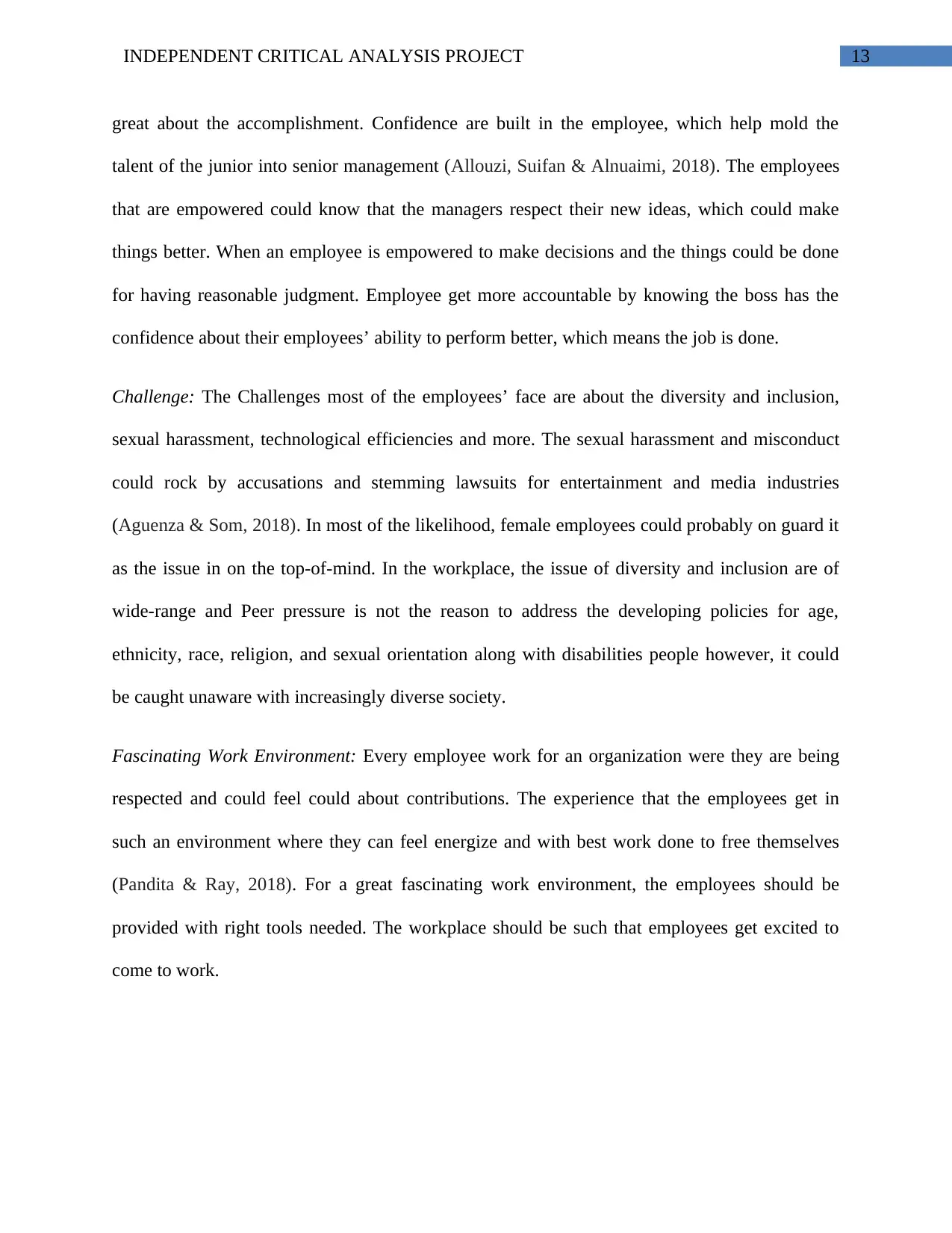
13INDEPENDENT CRITICAL ANALYSIS PROJECT
great about the accomplishment. Confidence are built in the employee, which help mold the
talent of the junior into senior management (Allouzi, Suifan & Alnuaimi, 2018). The employees
that are empowered could know that the managers respect their new ideas, which could make
things better. When an employee is empowered to make decisions and the things could be done
for having reasonable judgment. Employee get more accountable by knowing the boss has the
confidence about their employees’ ability to perform better, which means the job is done.
Challenge: The Challenges most of the employees’ face are about the diversity and inclusion,
sexual harassment, technological efficiencies and more. The sexual harassment and misconduct
could rock by accusations and stemming lawsuits for entertainment and media industries
(Aguenza & Som, 2018). In most of the likelihood, female employees could probably on guard it
as the issue in on the top-of-mind. In the workplace, the issue of diversity and inclusion are of
wide-range and Peer pressure is not the reason to address the developing policies for age,
ethnicity, race, religion, and sexual orientation along with disabilities people however, it could
be caught unaware with increasingly diverse society.
Fascinating Work Environment: Every employee work for an organization were they are being
respected and could feel could about contributions. The experience that the employees get in
such an environment where they can feel energize and with best work done to free themselves
(Pandita & Ray, 2018). For a great fascinating work environment, the employees should be
provided with right tools needed. The workplace should be such that employees get excited to
come to work.
great about the accomplishment. Confidence are built in the employee, which help mold the
talent of the junior into senior management (Allouzi, Suifan & Alnuaimi, 2018). The employees
that are empowered could know that the managers respect their new ideas, which could make
things better. When an employee is empowered to make decisions and the things could be done
for having reasonable judgment. Employee get more accountable by knowing the boss has the
confidence about their employees’ ability to perform better, which means the job is done.
Challenge: The Challenges most of the employees’ face are about the diversity and inclusion,
sexual harassment, technological efficiencies and more. The sexual harassment and misconduct
could rock by accusations and stemming lawsuits for entertainment and media industries
(Aguenza & Som, 2018). In most of the likelihood, female employees could probably on guard it
as the issue in on the top-of-mind. In the workplace, the issue of diversity and inclusion are of
wide-range and Peer pressure is not the reason to address the developing policies for age,
ethnicity, race, religion, and sexual orientation along with disabilities people however, it could
be caught unaware with increasingly diverse society.
Fascinating Work Environment: Every employee work for an organization were they are being
respected and could feel could about contributions. The experience that the employees get in
such an environment where they can feel energize and with best work done to free themselves
(Pandita & Ray, 2018). For a great fascinating work environment, the employees should be
provided with right tools needed. The workplace should be such that employees get excited to
come to work.
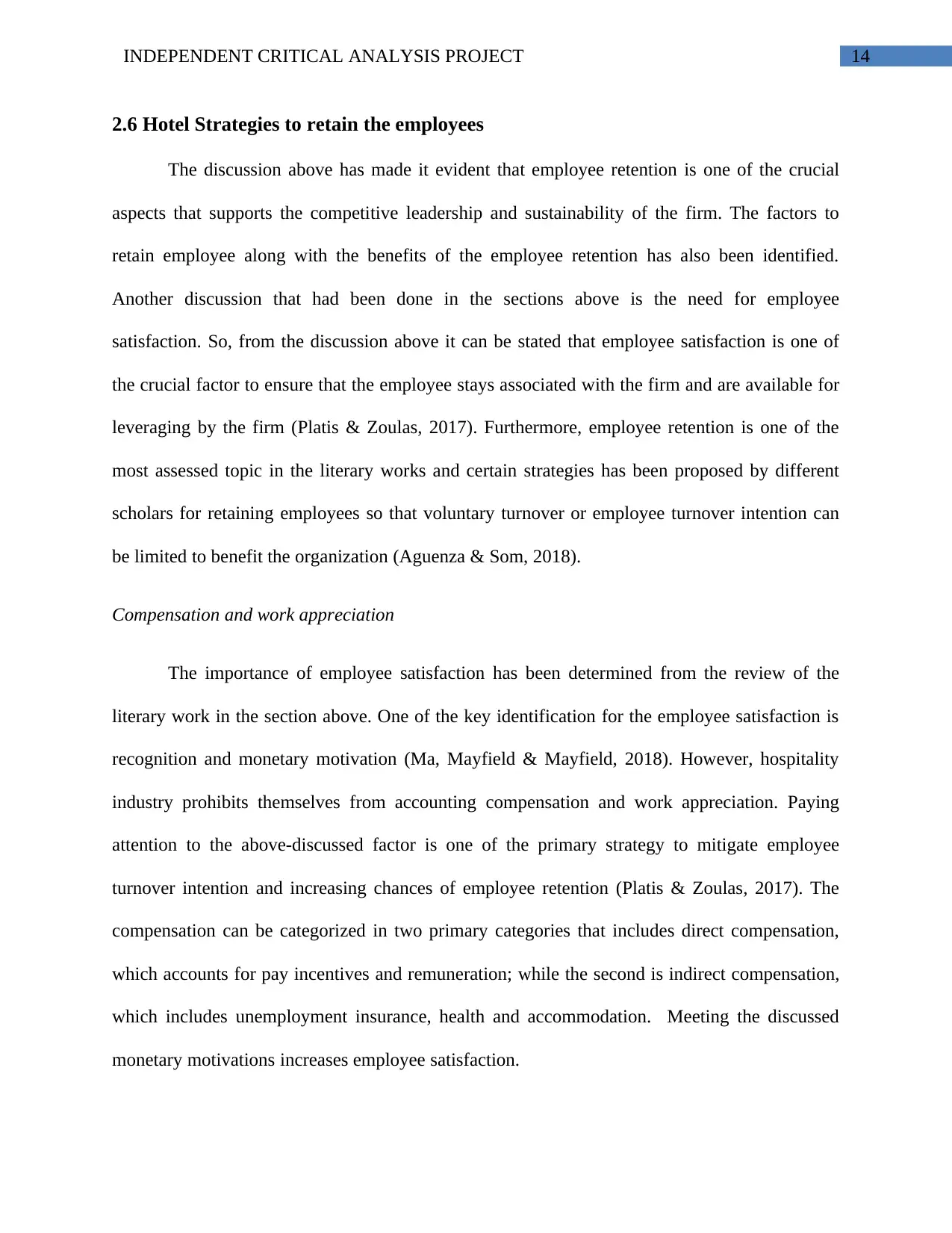
14INDEPENDENT CRITICAL ANALYSIS PROJECT
2.6 Hotel Strategies to retain the employees
The discussion above has made it evident that employee retention is one of the crucial
aspects that supports the competitive leadership and sustainability of the firm. The factors to
retain employee along with the benefits of the employee retention has also been identified.
Another discussion that had been done in the sections above is the need for employee
satisfaction. So, from the discussion above it can be stated that employee satisfaction is one of
the crucial factor to ensure that the employee stays associated with the firm and are available for
leveraging by the firm (Platis & Zoulas, 2017). Furthermore, employee retention is one of the
most assessed topic in the literary works and certain strategies has been proposed by different
scholars for retaining employees so that voluntary turnover or employee turnover intention can
be limited to benefit the organization (Aguenza & Som, 2018).
Compensation and work appreciation
The importance of employee satisfaction has been determined from the review of the
literary work in the section above. One of the key identification for the employee satisfaction is
recognition and monetary motivation (Ma, Mayfield & Mayfield, 2018). However, hospitality
industry prohibits themselves from accounting compensation and work appreciation. Paying
attention to the above-discussed factor is one of the primary strategy to mitigate employee
turnover intention and increasing chances of employee retention (Platis & Zoulas, 2017). The
compensation can be categorized in two primary categories that includes direct compensation,
which accounts for pay incentives and remuneration; while the second is indirect compensation,
which includes unemployment insurance, health and accommodation. Meeting the discussed
monetary motivations increases employee satisfaction.
2.6 Hotel Strategies to retain the employees
The discussion above has made it evident that employee retention is one of the crucial
aspects that supports the competitive leadership and sustainability of the firm. The factors to
retain employee along with the benefits of the employee retention has also been identified.
Another discussion that had been done in the sections above is the need for employee
satisfaction. So, from the discussion above it can be stated that employee satisfaction is one of
the crucial factor to ensure that the employee stays associated with the firm and are available for
leveraging by the firm (Platis & Zoulas, 2017). Furthermore, employee retention is one of the
most assessed topic in the literary works and certain strategies has been proposed by different
scholars for retaining employees so that voluntary turnover or employee turnover intention can
be limited to benefit the organization (Aguenza & Som, 2018).
Compensation and work appreciation
The importance of employee satisfaction has been determined from the review of the
literary work in the section above. One of the key identification for the employee satisfaction is
recognition and monetary motivation (Ma, Mayfield & Mayfield, 2018). However, hospitality
industry prohibits themselves from accounting compensation and work appreciation. Paying
attention to the above-discussed factor is one of the primary strategy to mitigate employee
turnover intention and increasing chances of employee retention (Platis & Zoulas, 2017). The
compensation can be categorized in two primary categories that includes direct compensation,
which accounts for pay incentives and remuneration; while the second is indirect compensation,
which includes unemployment insurance, health and accommodation. Meeting the discussed
monetary motivations increases employee satisfaction.
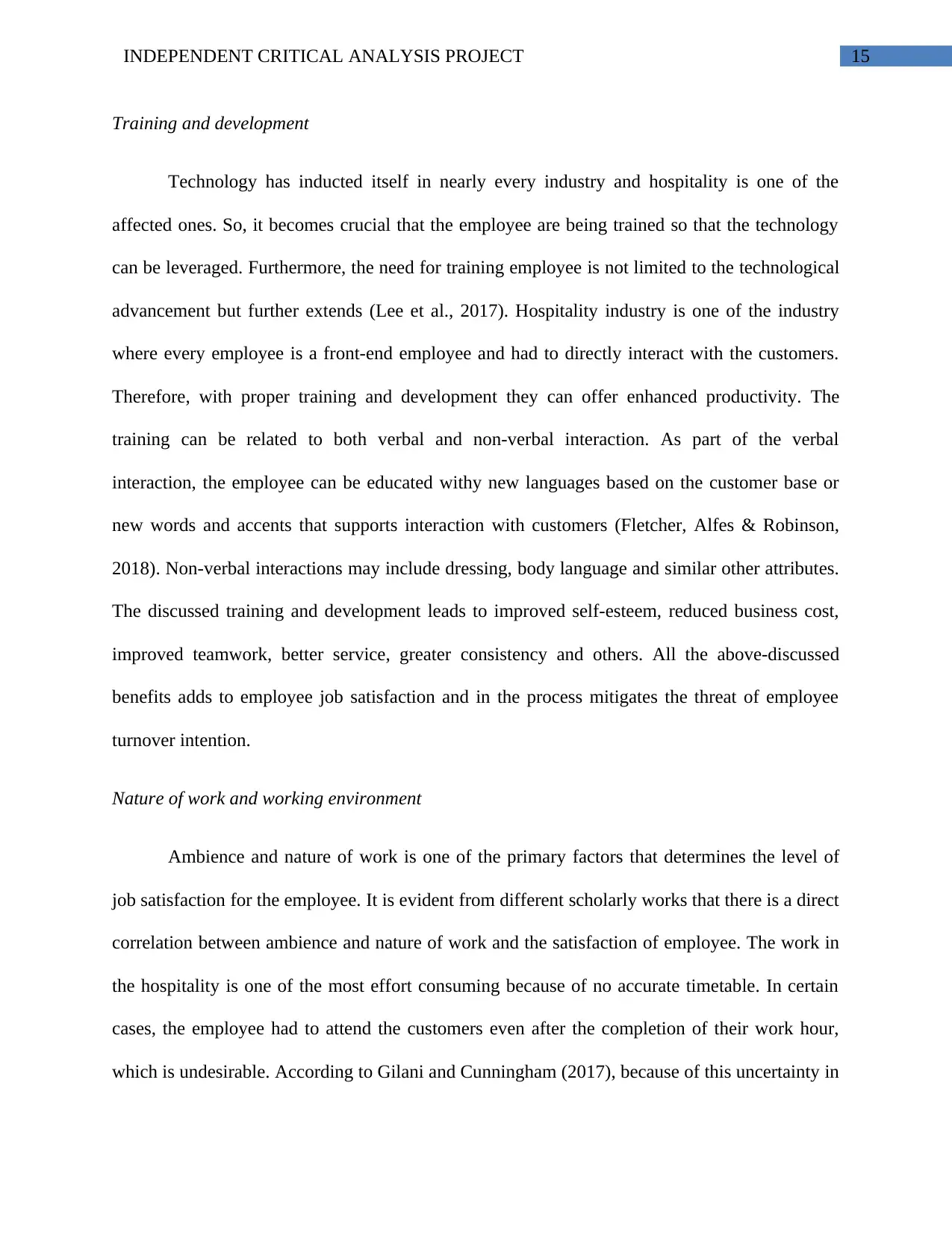
15INDEPENDENT CRITICAL ANALYSIS PROJECT
Training and development
Technology has inducted itself in nearly every industry and hospitality is one of the
affected ones. So, it becomes crucial that the employee are being trained so that the technology
can be leveraged. Furthermore, the need for training employee is not limited to the technological
advancement but further extends (Lee et al., 2017). Hospitality industry is one of the industry
where every employee is a front-end employee and had to directly interact with the customers.
Therefore, with proper training and development they can offer enhanced productivity. The
training can be related to both verbal and non-verbal interaction. As part of the verbal
interaction, the employee can be educated withy new languages based on the customer base or
new words and accents that supports interaction with customers (Fletcher, Alfes & Robinson,
2018). Non-verbal interactions may include dressing, body language and similar other attributes.
The discussed training and development leads to improved self-esteem, reduced business cost,
improved teamwork, better service, greater consistency and others. All the above-discussed
benefits adds to employee job satisfaction and in the process mitigates the threat of employee
turnover intention.
Nature of work and working environment
Ambience and nature of work is one of the primary factors that determines the level of
job satisfaction for the employee. It is evident from different scholarly works that there is a direct
correlation between ambience and nature of work and the satisfaction of employee. The work in
the hospitality is one of the most effort consuming because of no accurate timetable. In certain
cases, the employee had to attend the customers even after the completion of their work hour,
which is undesirable. According to Gilani and Cunningham (2017), because of this uncertainty in
Training and development
Technology has inducted itself in nearly every industry and hospitality is one of the
affected ones. So, it becomes crucial that the employee are being trained so that the technology
can be leveraged. Furthermore, the need for training employee is not limited to the technological
advancement but further extends (Lee et al., 2017). Hospitality industry is one of the industry
where every employee is a front-end employee and had to directly interact with the customers.
Therefore, with proper training and development they can offer enhanced productivity. The
training can be related to both verbal and non-verbal interaction. As part of the verbal
interaction, the employee can be educated withy new languages based on the customer base or
new words and accents that supports interaction with customers (Fletcher, Alfes & Robinson,
2018). Non-verbal interactions may include dressing, body language and similar other attributes.
The discussed training and development leads to improved self-esteem, reduced business cost,
improved teamwork, better service, greater consistency and others. All the above-discussed
benefits adds to employee job satisfaction and in the process mitigates the threat of employee
turnover intention.
Nature of work and working environment
Ambience and nature of work is one of the primary factors that determines the level of
job satisfaction for the employee. It is evident from different scholarly works that there is a direct
correlation between ambience and nature of work and the satisfaction of employee. The work in
the hospitality is one of the most effort consuming because of no accurate timetable. In certain
cases, the employee had to attend the customers even after the completion of their work hour,
which is undesirable. According to Gilani and Cunningham (2017), because of this uncertainty in
Secure Best Marks with AI Grader
Need help grading? Try our AI Grader for instant feedback on your assignments.
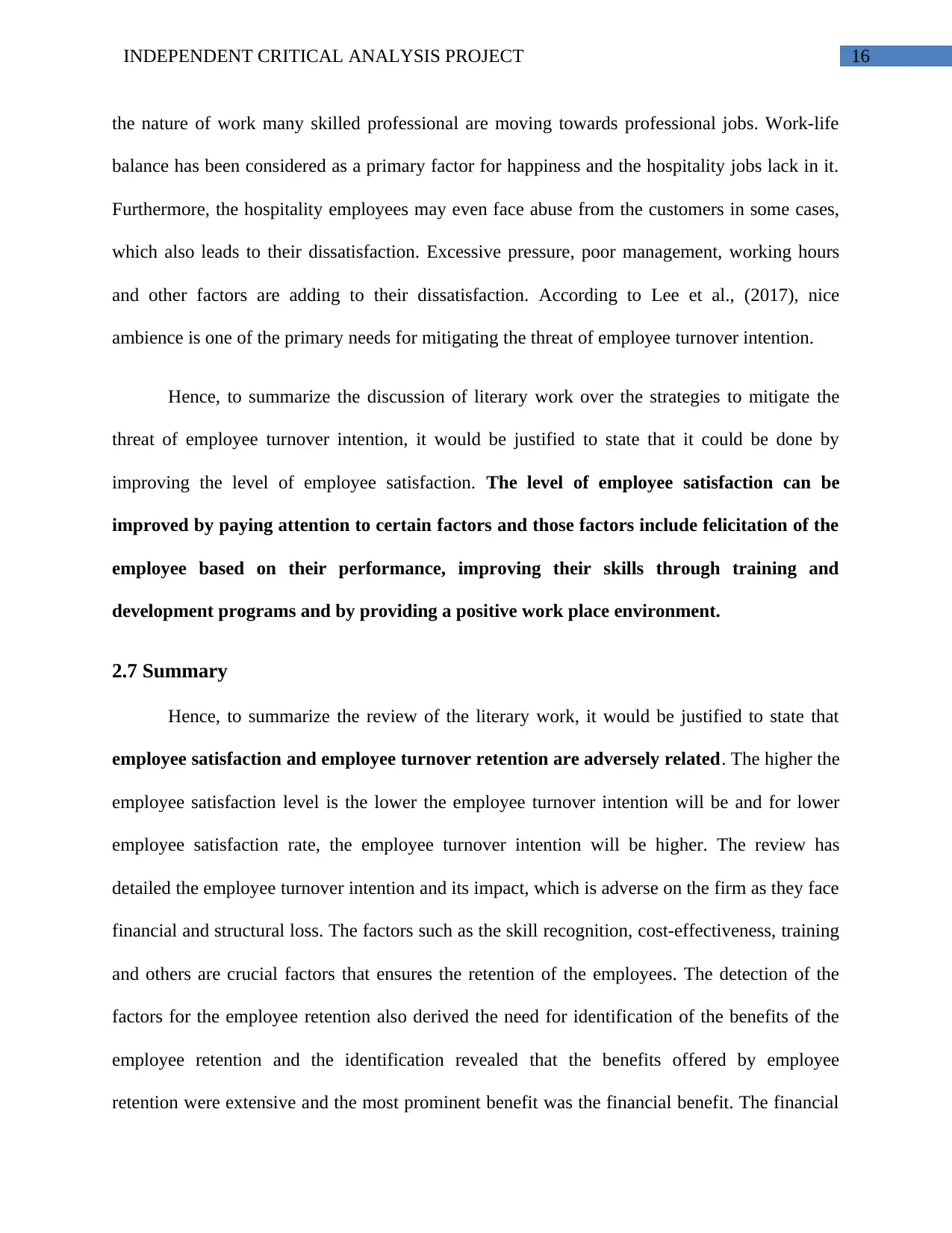
16INDEPENDENT CRITICAL ANALYSIS PROJECT
the nature of work many skilled professional are moving towards professional jobs. Work-life
balance has been considered as a primary factor for happiness and the hospitality jobs lack in it.
Furthermore, the hospitality employees may even face abuse from the customers in some cases,
which also leads to their dissatisfaction. Excessive pressure, poor management, working hours
and other factors are adding to their dissatisfaction. According to Lee et al., (2017), nice
ambience is one of the primary needs for mitigating the threat of employee turnover intention.
Hence, to summarize the discussion of literary work over the strategies to mitigate the
threat of employee turnover intention, it would be justified to state that it could be done by
improving the level of employee satisfaction. The level of employee satisfaction can be
improved by paying attention to certain factors and those factors include felicitation of the
employee based on their performance, improving their skills through training and
development programs and by providing a positive work place environment.
2.7 Summary
Hence, to summarize the review of the literary work, it would be justified to state that
employee satisfaction and employee turnover retention are adversely related. The higher the
employee satisfaction level is the lower the employee turnover intention will be and for lower
employee satisfaction rate, the employee turnover intention will be higher. The review has
detailed the employee turnover intention and its impact, which is adverse on the firm as they face
financial and structural loss. The factors such as the skill recognition, cost-effectiveness, training
and others are crucial factors that ensures the retention of the employees. The detection of the
factors for the employee retention also derived the need for identification of the benefits of the
employee retention and the identification revealed that the benefits offered by employee
retention were extensive and the most prominent benefit was the financial benefit. The financial
the nature of work many skilled professional are moving towards professional jobs. Work-life
balance has been considered as a primary factor for happiness and the hospitality jobs lack in it.
Furthermore, the hospitality employees may even face abuse from the customers in some cases,
which also leads to their dissatisfaction. Excessive pressure, poor management, working hours
and other factors are adding to their dissatisfaction. According to Lee et al., (2017), nice
ambience is one of the primary needs for mitigating the threat of employee turnover intention.
Hence, to summarize the discussion of literary work over the strategies to mitigate the
threat of employee turnover intention, it would be justified to state that it could be done by
improving the level of employee satisfaction. The level of employee satisfaction can be
improved by paying attention to certain factors and those factors include felicitation of the
employee based on their performance, improving their skills through training and
development programs and by providing a positive work place environment.
2.7 Summary
Hence, to summarize the review of the literary work, it would be justified to state that
employee satisfaction and employee turnover retention are adversely related. The higher the
employee satisfaction level is the lower the employee turnover intention will be and for lower
employee satisfaction rate, the employee turnover intention will be higher. The review has
detailed the employee turnover intention and its impact, which is adverse on the firm as they face
financial and structural loss. The factors such as the skill recognition, cost-effectiveness, training
and others are crucial factors that ensures the retention of the employees. The detection of the
factors for the employee retention also derived the need for identification of the benefits of the
employee retention and the identification revealed that the benefits offered by employee
retention were extensive and the most prominent benefit was the financial benefit. The financial
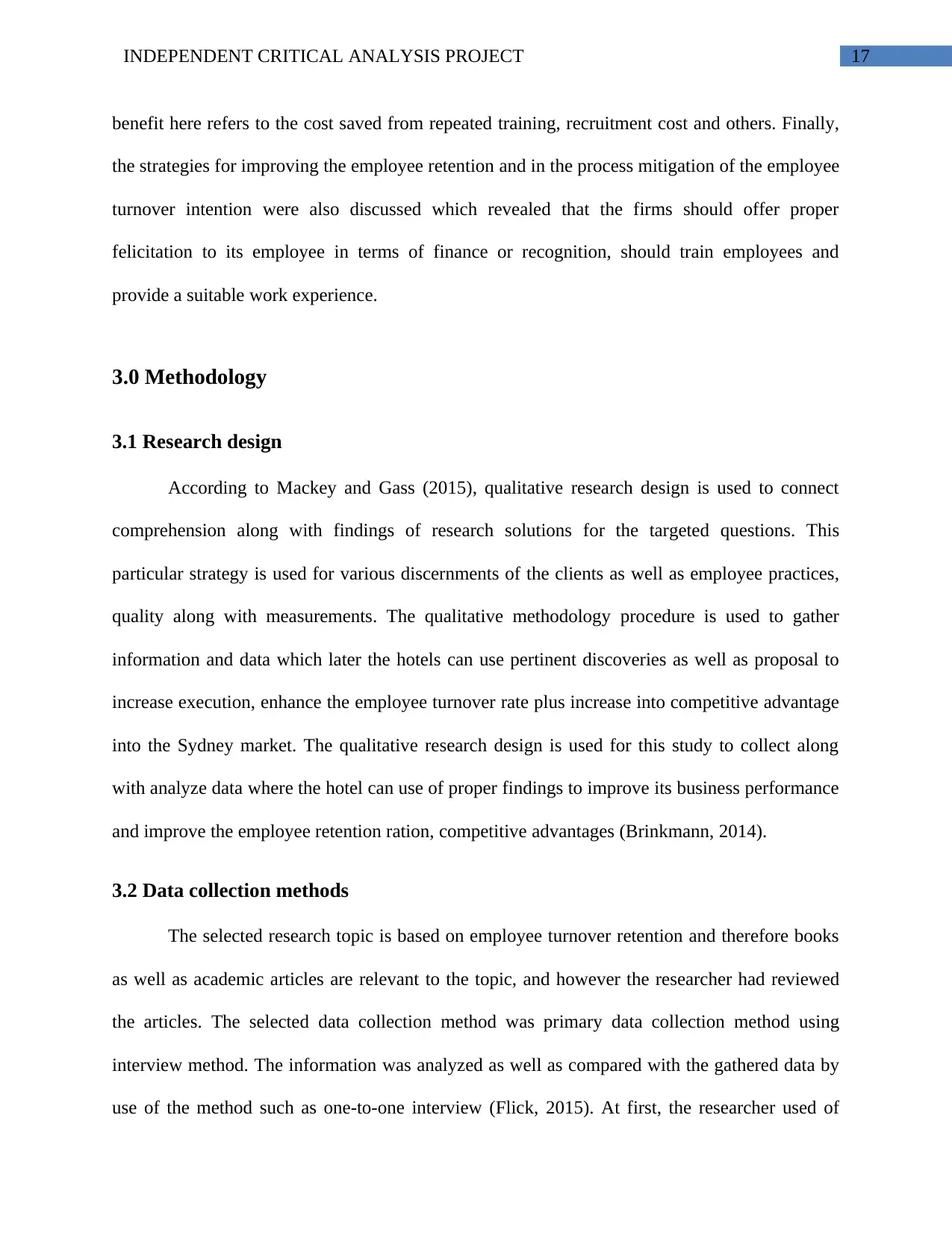
17INDEPENDENT CRITICAL ANALYSIS PROJECT
benefit here refers to the cost saved from repeated training, recruitment cost and others. Finally,
the strategies for improving the employee retention and in the process mitigation of the employee
turnover intention were also discussed which revealed that the firms should offer proper
felicitation to its employee in terms of finance or recognition, should train employees and
provide a suitable work experience.
3.0 Methodology
3.1 Research design
According to Mackey and Gass (2015), qualitative research design is used to connect
comprehension along with findings of research solutions for the targeted questions. This
particular strategy is used for various discernments of the clients as well as employee practices,
quality along with measurements. The qualitative methodology procedure is used to gather
information and data which later the hotels can use pertinent discoveries as well as proposal to
increase execution, enhance the employee turnover rate plus increase into competitive advantage
into the Sydney market. The qualitative research design is used for this study to collect along
with analyze data where the hotel can use of proper findings to improve its business performance
and improve the employee retention ration, competitive advantages (Brinkmann, 2014).
3.2 Data collection methods
The selected research topic is based on employee turnover retention and therefore books
as well as academic articles are relevant to the topic, and however the researcher had reviewed
the articles. The selected data collection method was primary data collection method using
interview method. The information was analyzed as well as compared with the gathered data by
use of the method such as one-to-one interview (Flick, 2015). At first, the researcher used of
benefit here refers to the cost saved from repeated training, recruitment cost and others. Finally,
the strategies for improving the employee retention and in the process mitigation of the employee
turnover intention were also discussed which revealed that the firms should offer proper
felicitation to its employee in terms of finance or recognition, should train employees and
provide a suitable work experience.
3.0 Methodology
3.1 Research design
According to Mackey and Gass (2015), qualitative research design is used to connect
comprehension along with findings of research solutions for the targeted questions. This
particular strategy is used for various discernments of the clients as well as employee practices,
quality along with measurements. The qualitative methodology procedure is used to gather
information and data which later the hotels can use pertinent discoveries as well as proposal to
increase execution, enhance the employee turnover rate plus increase into competitive advantage
into the Sydney market. The qualitative research design is used for this study to collect along
with analyze data where the hotel can use of proper findings to improve its business performance
and improve the employee retention ration, competitive advantages (Brinkmann, 2014).
3.2 Data collection methods
The selected research topic is based on employee turnover retention and therefore books
as well as academic articles are relevant to the topic, and however the researcher had reviewed
the articles. The selected data collection method was primary data collection method using
interview method. The information was analyzed as well as compared with the gathered data by
use of the method such as one-to-one interview (Flick, 2015). At first, the researcher used of
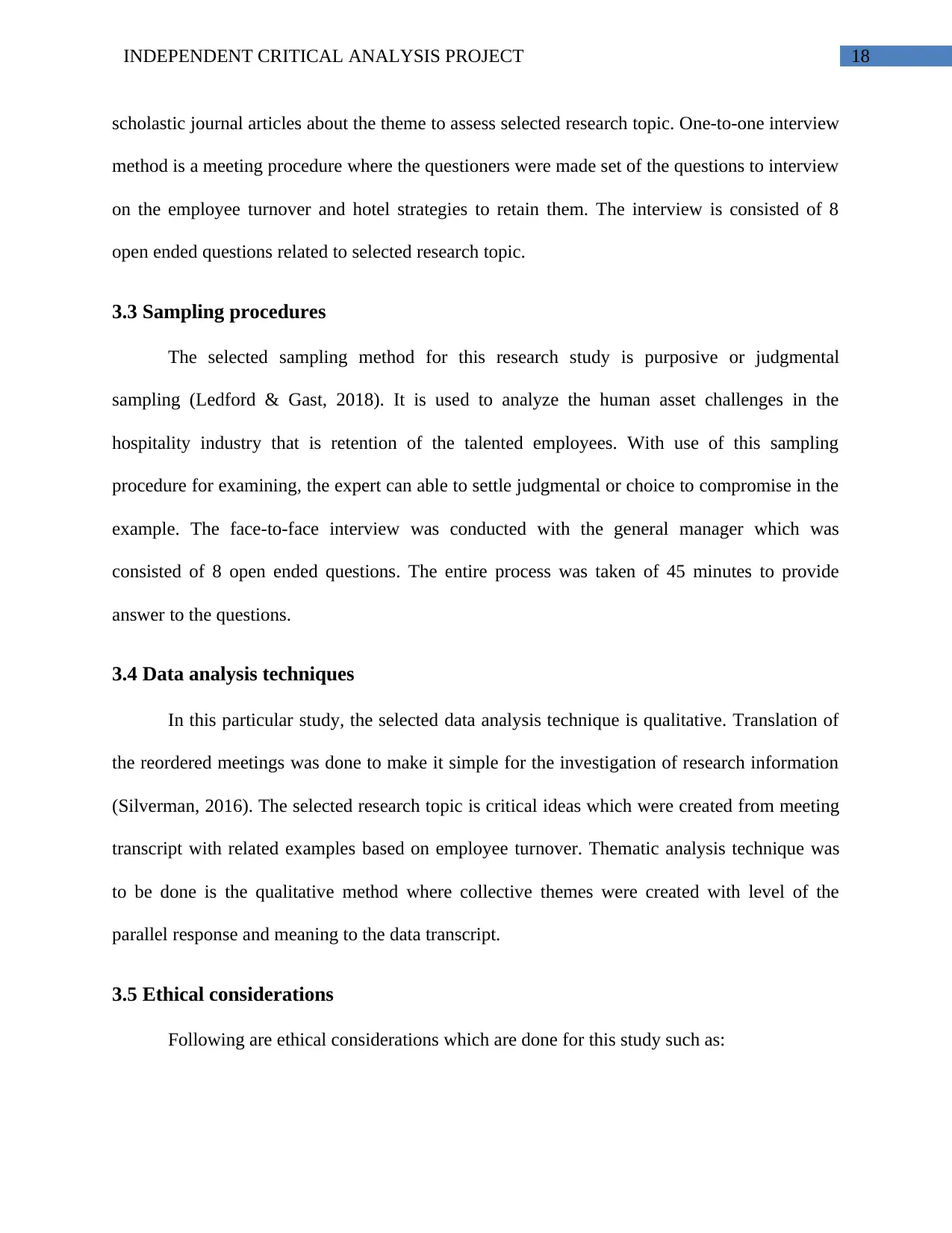
18INDEPENDENT CRITICAL ANALYSIS PROJECT
scholastic journal articles about the theme to assess selected research topic. One-to-one interview
method is a meeting procedure where the questioners were made set of the questions to interview
on the employee turnover and hotel strategies to retain them. The interview is consisted of 8
open ended questions related to selected research topic.
3.3 Sampling procedures
The selected sampling method for this research study is purposive or judgmental
sampling (Ledford & Gast, 2018). It is used to analyze the human asset challenges in the
hospitality industry that is retention of the talented employees. With use of this sampling
procedure for examining, the expert can able to settle judgmental or choice to compromise in the
example. The face-to-face interview was conducted with the general manager which was
consisted of 8 open ended questions. The entire process was taken of 45 minutes to provide
answer to the questions.
3.4 Data analysis techniques
In this particular study, the selected data analysis technique is qualitative. Translation of
the reordered meetings was done to make it simple for the investigation of research information
(Silverman, 2016). The selected research topic is critical ideas which were created from meeting
transcript with related examples based on employee turnover. Thematic analysis technique was
to be done is the qualitative method where collective themes were created with level of the
parallel response and meaning to the data transcript.
3.5 Ethical considerations
Following are ethical considerations which are done for this study such as:
scholastic journal articles about the theme to assess selected research topic. One-to-one interview
method is a meeting procedure where the questioners were made set of the questions to interview
on the employee turnover and hotel strategies to retain them. The interview is consisted of 8
open ended questions related to selected research topic.
3.3 Sampling procedures
The selected sampling method for this research study is purposive or judgmental
sampling (Ledford & Gast, 2018). It is used to analyze the human asset challenges in the
hospitality industry that is retention of the talented employees. With use of this sampling
procedure for examining, the expert can able to settle judgmental or choice to compromise in the
example. The face-to-face interview was conducted with the general manager which was
consisted of 8 open ended questions. The entire process was taken of 45 minutes to provide
answer to the questions.
3.4 Data analysis techniques
In this particular study, the selected data analysis technique is qualitative. Translation of
the reordered meetings was done to make it simple for the investigation of research information
(Silverman, 2016). The selected research topic is critical ideas which were created from meeting
transcript with related examples based on employee turnover. Thematic analysis technique was
to be done is the qualitative method where collective themes were created with level of the
parallel response and meaning to the data transcript.
3.5 Ethical considerations
Following are ethical considerations which are done for this study such as:
Paraphrase This Document
Need a fresh take? Get an instant paraphrase of this document with our AI Paraphraser
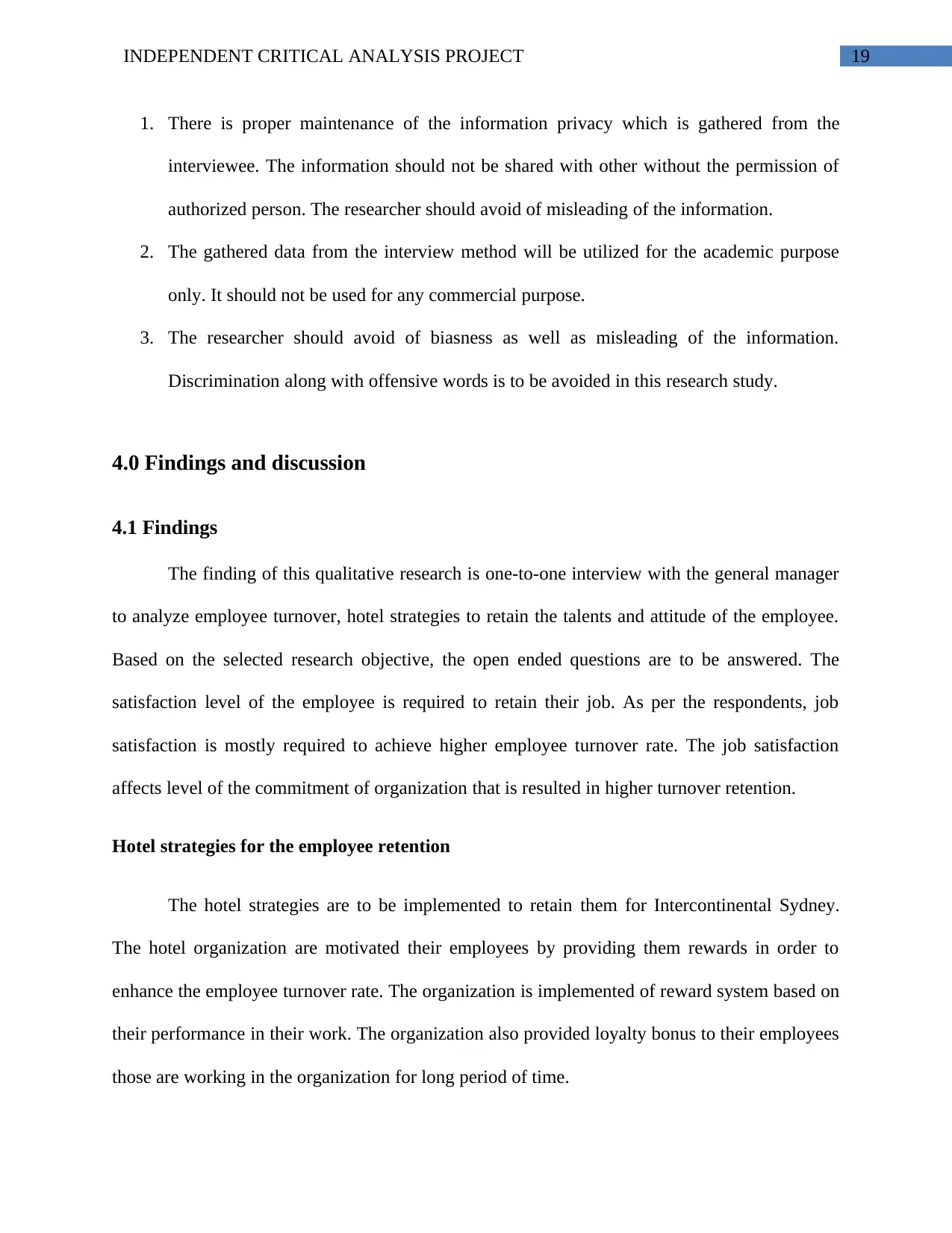
19INDEPENDENT CRITICAL ANALYSIS PROJECT
1. There is proper maintenance of the information privacy which is gathered from the
interviewee. The information should not be shared with other without the permission of
authorized person. The researcher should avoid of misleading of the information.
2. The gathered data from the interview method will be utilized for the academic purpose
only. It should not be used for any commercial purpose.
3. The researcher should avoid of biasness as well as misleading of the information.
Discrimination along with offensive words is to be avoided in this research study.
4.0 Findings and discussion
4.1 Findings
The finding of this qualitative research is one-to-one interview with the general manager
to analyze employee turnover, hotel strategies to retain the talents and attitude of the employee.
Based on the selected research objective, the open ended questions are to be answered. The
satisfaction level of the employee is required to retain their job. As per the respondents, job
satisfaction is mostly required to achieve higher employee turnover rate. The job satisfaction
affects level of the commitment of organization that is resulted in higher turnover retention.
Hotel strategies for the employee retention
The hotel strategies are to be implemented to retain them for Intercontinental Sydney.
The hotel organization are motivated their employees by providing them rewards in order to
enhance the employee turnover rate. The organization is implemented of reward system based on
their performance in their work. The organization also provided loyalty bonus to their employees
those are working in the organization for long period of time.
1. There is proper maintenance of the information privacy which is gathered from the
interviewee. The information should not be shared with other without the permission of
authorized person. The researcher should avoid of misleading of the information.
2. The gathered data from the interview method will be utilized for the academic purpose
only. It should not be used for any commercial purpose.
3. The researcher should avoid of biasness as well as misleading of the information.
Discrimination along with offensive words is to be avoided in this research study.
4.0 Findings and discussion
4.1 Findings
The finding of this qualitative research is one-to-one interview with the general manager
to analyze employee turnover, hotel strategies to retain the talents and attitude of the employee.
Based on the selected research objective, the open ended questions are to be answered. The
satisfaction level of the employee is required to retain their job. As per the respondents, job
satisfaction is mostly required to achieve higher employee turnover rate. The job satisfaction
affects level of the commitment of organization that is resulted in higher turnover retention.
Hotel strategies for the employee retention
The hotel strategies are to be implemented to retain them for Intercontinental Sydney.
The hotel organization are motivated their employees by providing them rewards in order to
enhance the employee turnover rate. The organization is implemented of reward system based on
their performance in their work. The organization also provided loyalty bonus to their employees
those are working in the organization for long period of time.
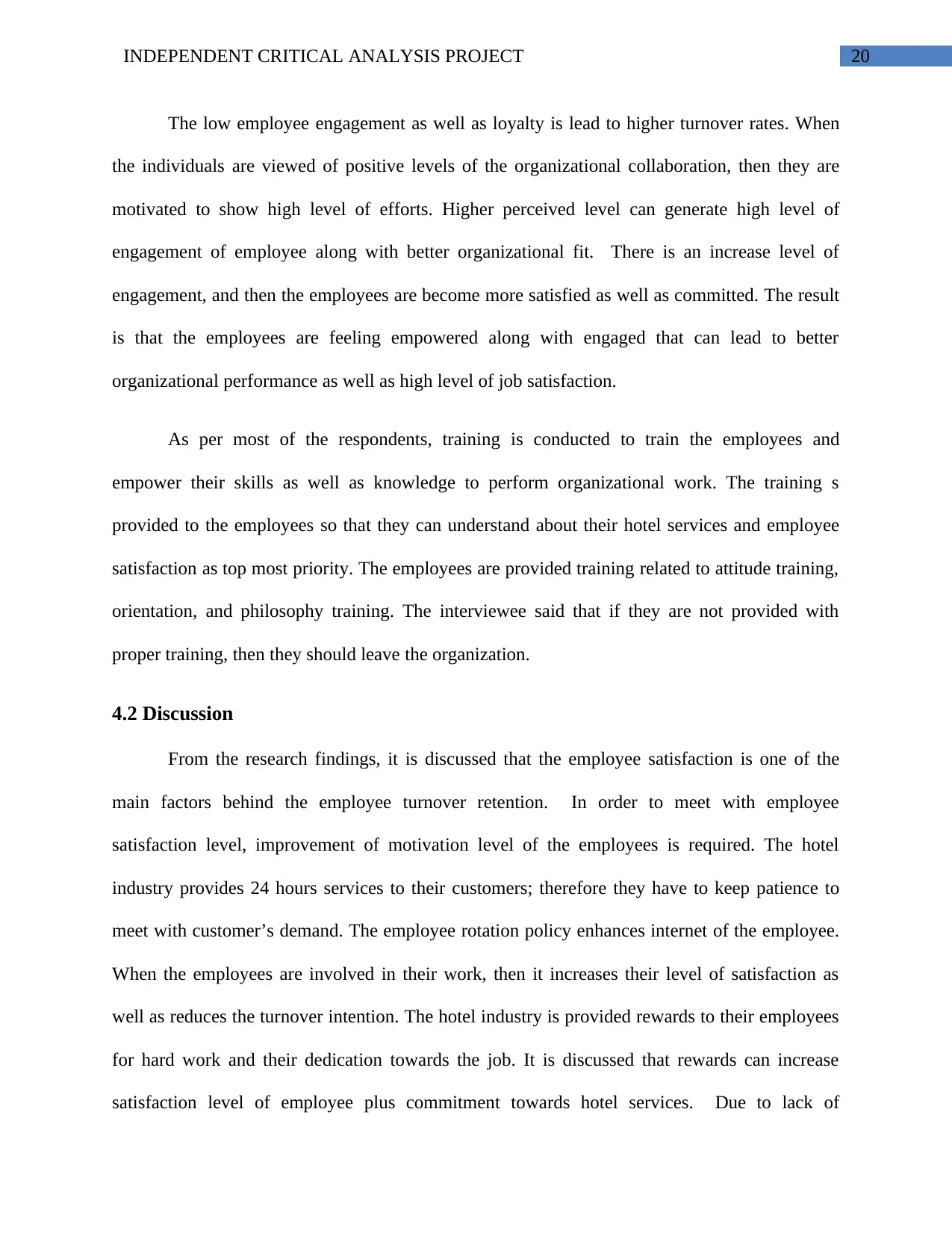
20INDEPENDENT CRITICAL ANALYSIS PROJECT
The low employee engagement as well as loyalty is lead to higher turnover rates. When
the individuals are viewed of positive levels of the organizational collaboration, then they are
motivated to show high level of efforts. Higher perceived level can generate high level of
engagement of employee along with better organizational fit. There is an increase level of
engagement, and then the employees are become more satisfied as well as committed. The result
is that the employees are feeling empowered along with engaged that can lead to better
organizational performance as well as high level of job satisfaction.
As per most of the respondents, training is conducted to train the employees and
empower their skills as well as knowledge to perform organizational work. The training s
provided to the employees so that they can understand about their hotel services and employee
satisfaction as top most priority. The employees are provided training related to attitude training,
orientation, and philosophy training. The interviewee said that if they are not provided with
proper training, then they should leave the organization.
4.2 Discussion
From the research findings, it is discussed that the employee satisfaction is one of the
main factors behind the employee turnover retention. In order to meet with employee
satisfaction level, improvement of motivation level of the employees is required. The hotel
industry provides 24 hours services to their customers; therefore they have to keep patience to
meet with customer’s demand. The employee rotation policy enhances internet of the employee.
When the employees are involved in their work, then it increases their level of satisfaction as
well as reduces the turnover intention. The hotel industry is provided rewards to their employees
for hard work and their dedication towards the job. It is discussed that rewards can increase
satisfaction level of employee plus commitment towards hotel services. Due to lack of
The low employee engagement as well as loyalty is lead to higher turnover rates. When
the individuals are viewed of positive levels of the organizational collaboration, then they are
motivated to show high level of efforts. Higher perceived level can generate high level of
engagement of employee along with better organizational fit. There is an increase level of
engagement, and then the employees are become more satisfied as well as committed. The result
is that the employees are feeling empowered along with engaged that can lead to better
organizational performance as well as high level of job satisfaction.
As per most of the respondents, training is conducted to train the employees and
empower their skills as well as knowledge to perform organizational work. The training s
provided to the employees so that they can understand about their hotel services and employee
satisfaction as top most priority. The employees are provided training related to attitude training,
orientation, and philosophy training. The interviewee said that if they are not provided with
proper training, then they should leave the organization.
4.2 Discussion
From the research findings, it is discussed that the employee satisfaction is one of the
main factors behind the employee turnover retention. In order to meet with employee
satisfaction level, improvement of motivation level of the employees is required. The hotel
industry provides 24 hours services to their customers; therefore they have to keep patience to
meet with customer’s demand. The employee rotation policy enhances internet of the employee.
When the employees are involved in their work, then it increases their level of satisfaction as
well as reduces the turnover intention. The hotel industry is provided rewards to their employees
for hard work and their dedication towards the job. It is discussed that rewards can increase
satisfaction level of employee plus commitment towards hotel services. Due to lack of
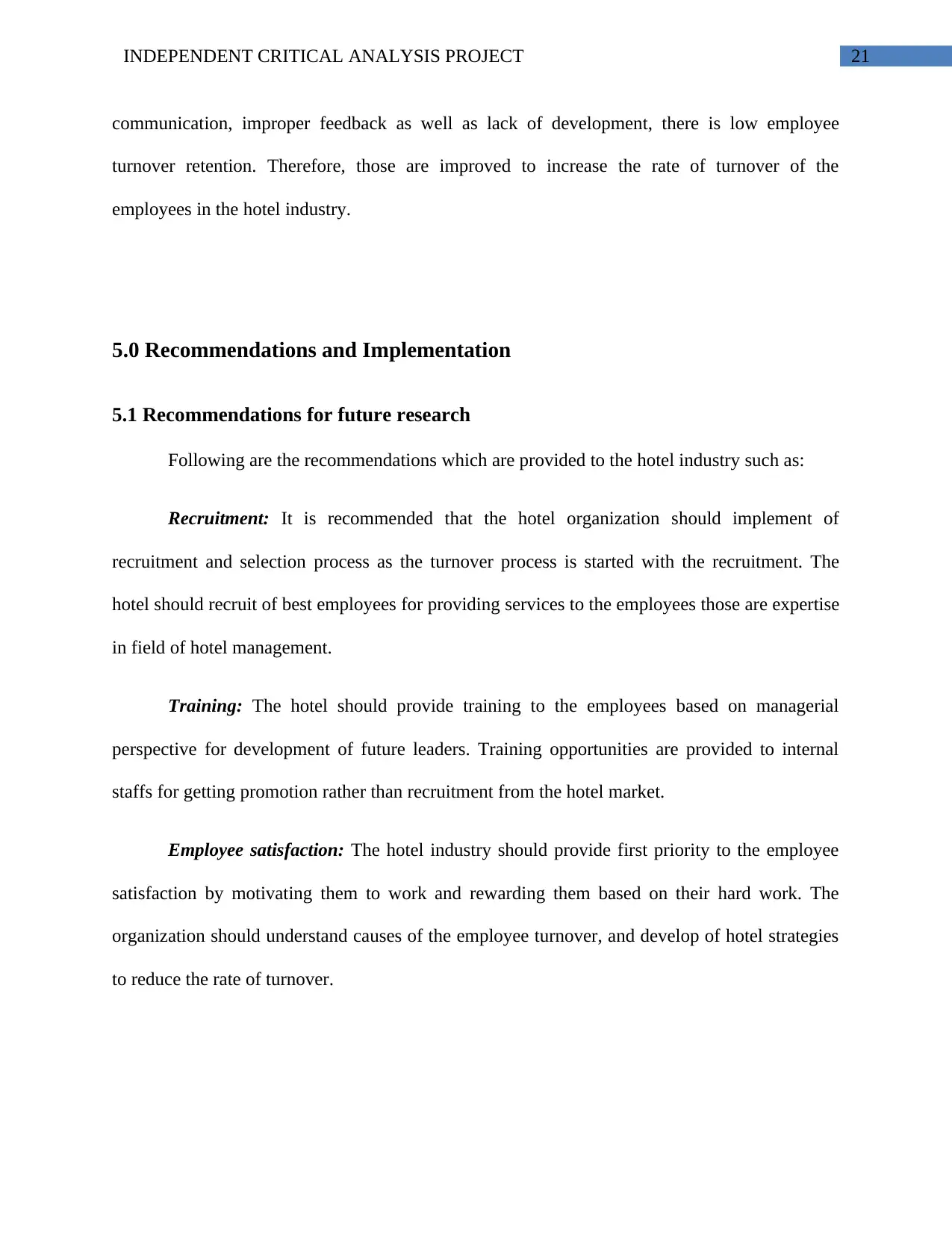
21INDEPENDENT CRITICAL ANALYSIS PROJECT
communication, improper feedback as well as lack of development, there is low employee
turnover retention. Therefore, those are improved to increase the rate of turnover of the
employees in the hotel industry.
5.0 Recommendations and Implementation
5.1 Recommendations for future research
Following are the recommendations which are provided to the hotel industry such as:
Recruitment: It is recommended that the hotel organization should implement of
recruitment and selection process as the turnover process is started with the recruitment. The
hotel should recruit of best employees for providing services to the employees those are expertise
in field of hotel management.
Training: The hotel should provide training to the employees based on managerial
perspective for development of future leaders. Training opportunities are provided to internal
staffs for getting promotion rather than recruitment from the hotel market.
Employee satisfaction: The hotel industry should provide first priority to the employee
satisfaction by motivating them to work and rewarding them based on their hard work. The
organization should understand causes of the employee turnover, and develop of hotel strategies
to reduce the rate of turnover.
communication, improper feedback as well as lack of development, there is low employee
turnover retention. Therefore, those are improved to increase the rate of turnover of the
employees in the hotel industry.
5.0 Recommendations and Implementation
5.1 Recommendations for future research
Following are the recommendations which are provided to the hotel industry such as:
Recruitment: It is recommended that the hotel organization should implement of
recruitment and selection process as the turnover process is started with the recruitment. The
hotel should recruit of best employees for providing services to the employees those are expertise
in field of hotel management.
Training: The hotel should provide training to the employees based on managerial
perspective for development of future leaders. Training opportunities are provided to internal
staffs for getting promotion rather than recruitment from the hotel market.
Employee satisfaction: The hotel industry should provide first priority to the employee
satisfaction by motivating them to work and rewarding them based on their hard work. The
organization should understand causes of the employee turnover, and develop of hotel strategies
to reduce the rate of turnover.
Secure Best Marks with AI Grader
Need help grading? Try our AI Grader for instant feedback on your assignments.
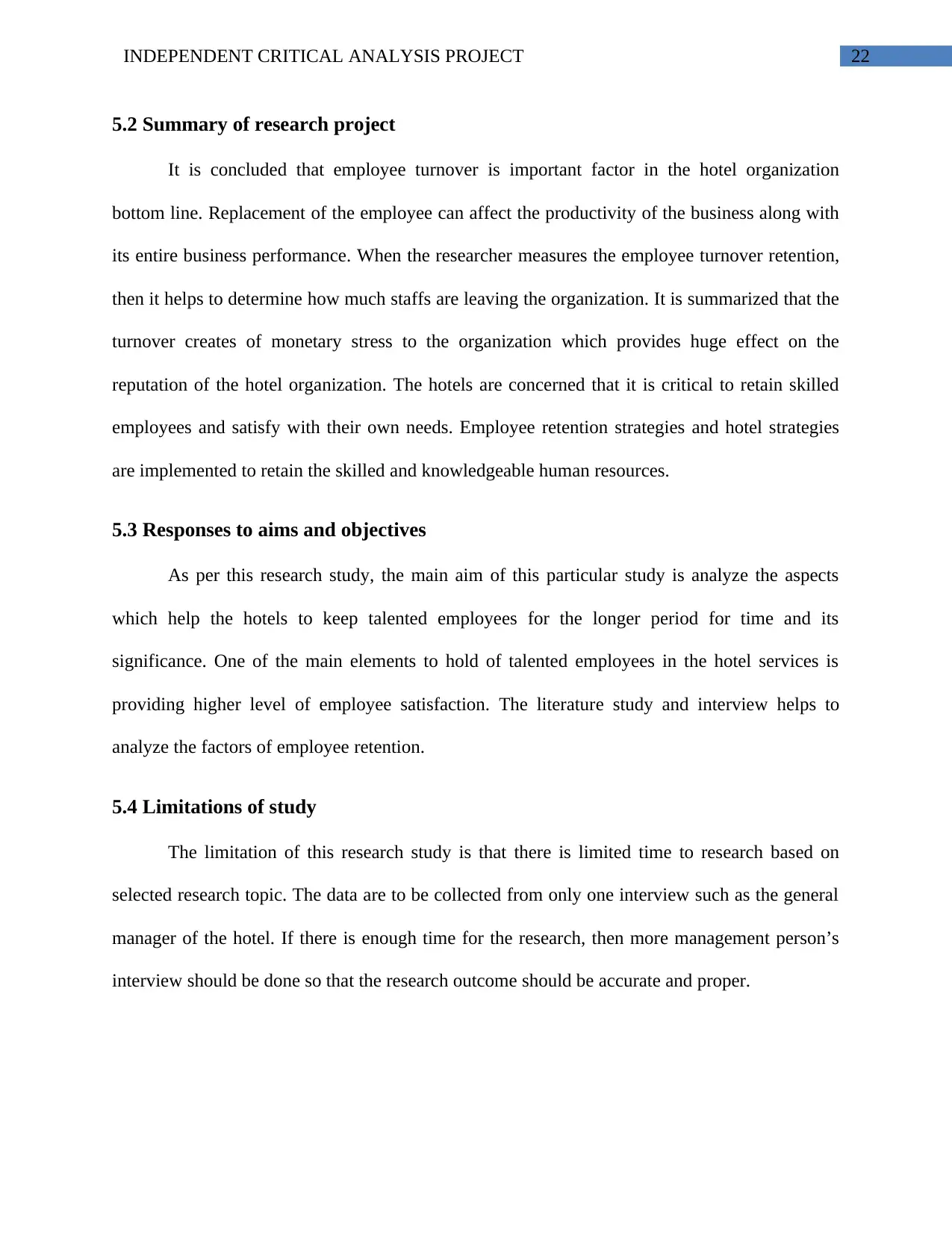
22INDEPENDENT CRITICAL ANALYSIS PROJECT
5.2 Summary of research project
It is concluded that employee turnover is important factor in the hotel organization
bottom line. Replacement of the employee can affect the productivity of the business along with
its entire business performance. When the researcher measures the employee turnover retention,
then it helps to determine how much staffs are leaving the organization. It is summarized that the
turnover creates of monetary stress to the organization which provides huge effect on the
reputation of the hotel organization. The hotels are concerned that it is critical to retain skilled
employees and satisfy with their own needs. Employee retention strategies and hotel strategies
are implemented to retain the skilled and knowledgeable human resources.
5.3 Responses to aims and objectives
As per this research study, the main aim of this particular study is analyze the aspects
which help the hotels to keep talented employees for the longer period for time and its
significance. One of the main elements to hold of talented employees in the hotel services is
providing higher level of employee satisfaction. The literature study and interview helps to
analyze the factors of employee retention.
5.4 Limitations of study
The limitation of this research study is that there is limited time to research based on
selected research topic. The data are to be collected from only one interview such as the general
manager of the hotel. If there is enough time for the research, then more management person’s
interview should be done so that the research outcome should be accurate and proper.
5.2 Summary of research project
It is concluded that employee turnover is important factor in the hotel organization
bottom line. Replacement of the employee can affect the productivity of the business along with
its entire business performance. When the researcher measures the employee turnover retention,
then it helps to determine how much staffs are leaving the organization. It is summarized that the
turnover creates of monetary stress to the organization which provides huge effect on the
reputation of the hotel organization. The hotels are concerned that it is critical to retain skilled
employees and satisfy with their own needs. Employee retention strategies and hotel strategies
are implemented to retain the skilled and knowledgeable human resources.
5.3 Responses to aims and objectives
As per this research study, the main aim of this particular study is analyze the aspects
which help the hotels to keep talented employees for the longer period for time and its
significance. One of the main elements to hold of talented employees in the hotel services is
providing higher level of employee satisfaction. The literature study and interview helps to
analyze the factors of employee retention.
5.4 Limitations of study
The limitation of this research study is that there is limited time to research based on
selected research topic. The data are to be collected from only one interview such as the general
manager of the hotel. If there is enough time for the research, then more management person’s
interview should be done so that the research outcome should be accurate and proper.
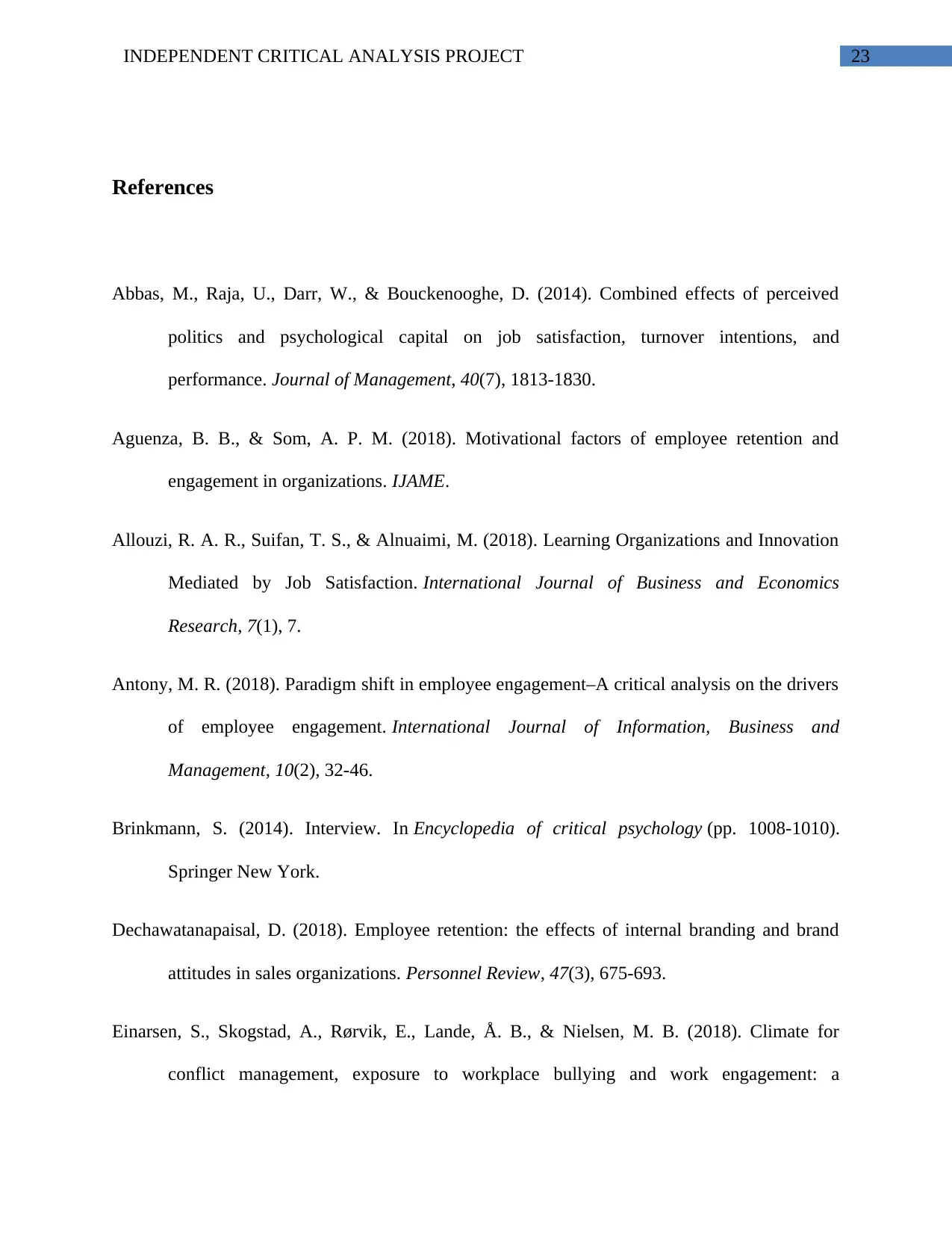
23INDEPENDENT CRITICAL ANALYSIS PROJECT
References
Abbas, M., Raja, U., Darr, W., & Bouckenooghe, D. (2014). Combined effects of perceived
politics and psychological capital on job satisfaction, turnover intentions, and
performance. Journal of Management, 40(7), 1813-1830.
Aguenza, B. B., & Som, A. P. M. (2018). Motivational factors of employee retention and
engagement in organizations. IJAME.
Allouzi, R. A. R., Suifan, T. S., & Alnuaimi, M. (2018). Learning Organizations and Innovation
Mediated by Job Satisfaction. International Journal of Business and Economics
Research, 7(1), 7.
Antony, M. R. (2018). Paradigm shift in employee engagement–A critical analysis on the drivers
of employee engagement. International Journal of Information, Business and
Management, 10(2), 32-46.
Brinkmann, S. (2014). Interview. In Encyclopedia of critical psychology (pp. 1008-1010).
Springer New York.
Dechawatanapaisal, D. (2018). Employee retention: the effects of internal branding and brand
attitudes in sales organizations. Personnel Review, 47(3), 675-693.
Einarsen, S., Skogstad, A., Rørvik, E., Lande, Å. B., & Nielsen, M. B. (2018). Climate for
conflict management, exposure to workplace bullying and work engagement: a
References
Abbas, M., Raja, U., Darr, W., & Bouckenooghe, D. (2014). Combined effects of perceived
politics and psychological capital on job satisfaction, turnover intentions, and
performance. Journal of Management, 40(7), 1813-1830.
Aguenza, B. B., & Som, A. P. M. (2018). Motivational factors of employee retention and
engagement in organizations. IJAME.
Allouzi, R. A. R., Suifan, T. S., & Alnuaimi, M. (2018). Learning Organizations and Innovation
Mediated by Job Satisfaction. International Journal of Business and Economics
Research, 7(1), 7.
Antony, M. R. (2018). Paradigm shift in employee engagement–A critical analysis on the drivers
of employee engagement. International Journal of Information, Business and
Management, 10(2), 32-46.
Brinkmann, S. (2014). Interview. In Encyclopedia of critical psychology (pp. 1008-1010).
Springer New York.
Dechawatanapaisal, D. (2018). Employee retention: the effects of internal branding and brand
attitudes in sales organizations. Personnel Review, 47(3), 675-693.
Einarsen, S., Skogstad, A., Rørvik, E., Lande, Å. B., & Nielsen, M. B. (2018). Climate for
conflict management, exposure to workplace bullying and work engagement: a
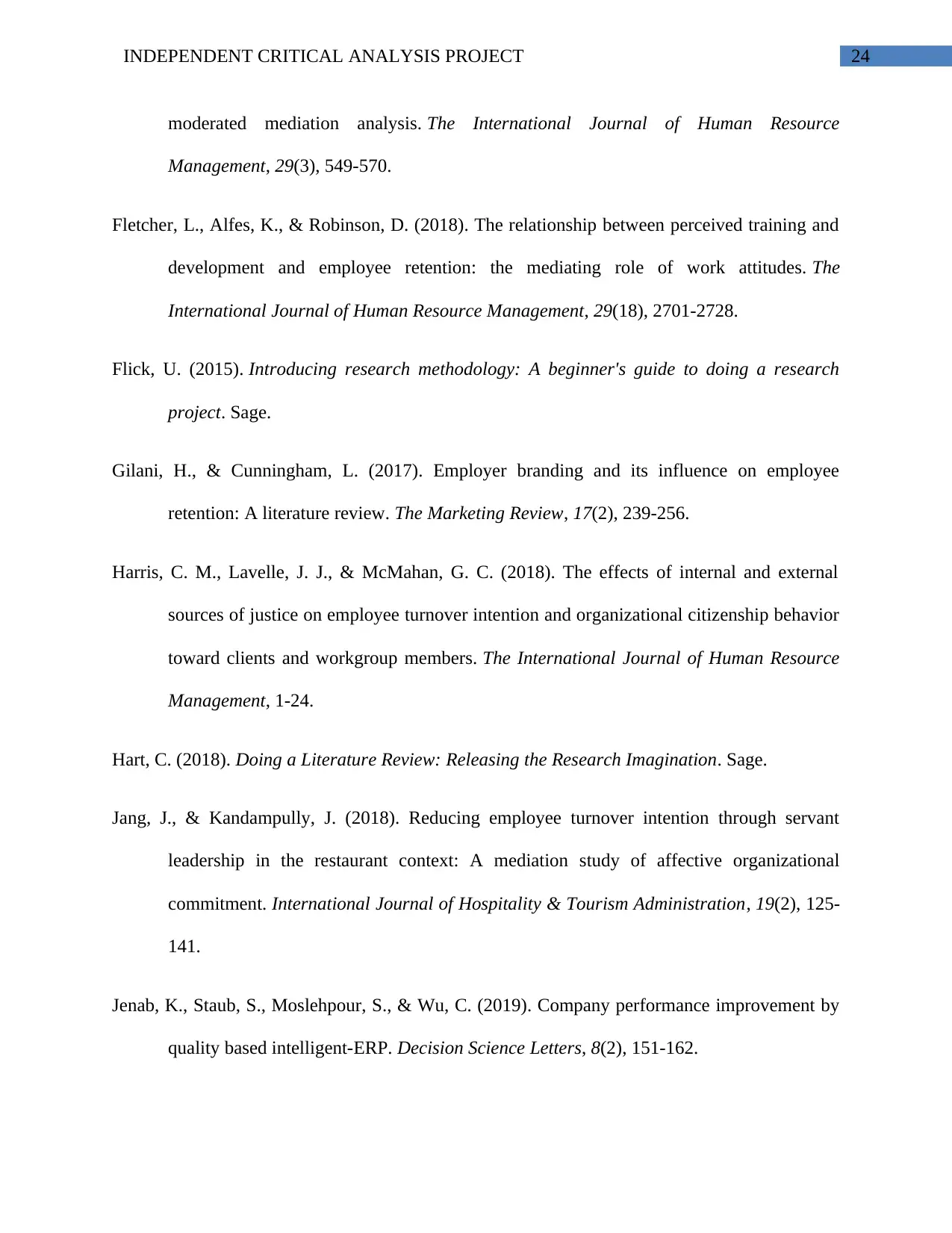
24INDEPENDENT CRITICAL ANALYSIS PROJECT
moderated mediation analysis. The International Journal of Human Resource
Management, 29(3), 549-570.
Fletcher, L., Alfes, K., & Robinson, D. (2018). The relationship between perceived training and
development and employee retention: the mediating role of work attitudes. The
International Journal of Human Resource Management, 29(18), 2701-2728.
Flick, U. (2015). Introducing research methodology: A beginner's guide to doing a research
project. Sage.
Gilani, H., & Cunningham, L. (2017). Employer branding and its influence on employee
retention: A literature review. The Marketing Review, 17(2), 239-256.
Harris, C. M., Lavelle, J. J., & McMahan, G. C. (2018). The effects of internal and external
sources of justice on employee turnover intention and organizational citizenship behavior
toward clients and workgroup members. The International Journal of Human Resource
Management, 1-24.
Hart, C. (2018). Doing a Literature Review: Releasing the Research Imagination. Sage.
Jang, J., & Kandampully, J. (2018). Reducing employee turnover intention through servant
leadership in the restaurant context: A mediation study of affective organizational
commitment. International Journal of Hospitality & Tourism Administration, 19(2), 125-
141.
Jenab, K., Staub, S., Moslehpour, S., & Wu, C. (2019). Company performance improvement by
quality based intelligent-ERP. Decision Science Letters, 8(2), 151-162.
moderated mediation analysis. The International Journal of Human Resource
Management, 29(3), 549-570.
Fletcher, L., Alfes, K., & Robinson, D. (2018). The relationship between perceived training and
development and employee retention: the mediating role of work attitudes. The
International Journal of Human Resource Management, 29(18), 2701-2728.
Flick, U. (2015). Introducing research methodology: A beginner's guide to doing a research
project. Sage.
Gilani, H., & Cunningham, L. (2017). Employer branding and its influence on employee
retention: A literature review. The Marketing Review, 17(2), 239-256.
Harris, C. M., Lavelle, J. J., & McMahan, G. C. (2018). The effects of internal and external
sources of justice on employee turnover intention and organizational citizenship behavior
toward clients and workgroup members. The International Journal of Human Resource
Management, 1-24.
Hart, C. (2018). Doing a Literature Review: Releasing the Research Imagination. Sage.
Jang, J., & Kandampully, J. (2018). Reducing employee turnover intention through servant
leadership in the restaurant context: A mediation study of affective organizational
commitment. International Journal of Hospitality & Tourism Administration, 19(2), 125-
141.
Jenab, K., Staub, S., Moslehpour, S., & Wu, C. (2019). Company performance improvement by
quality based intelligent-ERP. Decision Science Letters, 8(2), 151-162.
Paraphrase This Document
Need a fresh take? Get an instant paraphrase of this document with our AI Paraphraser
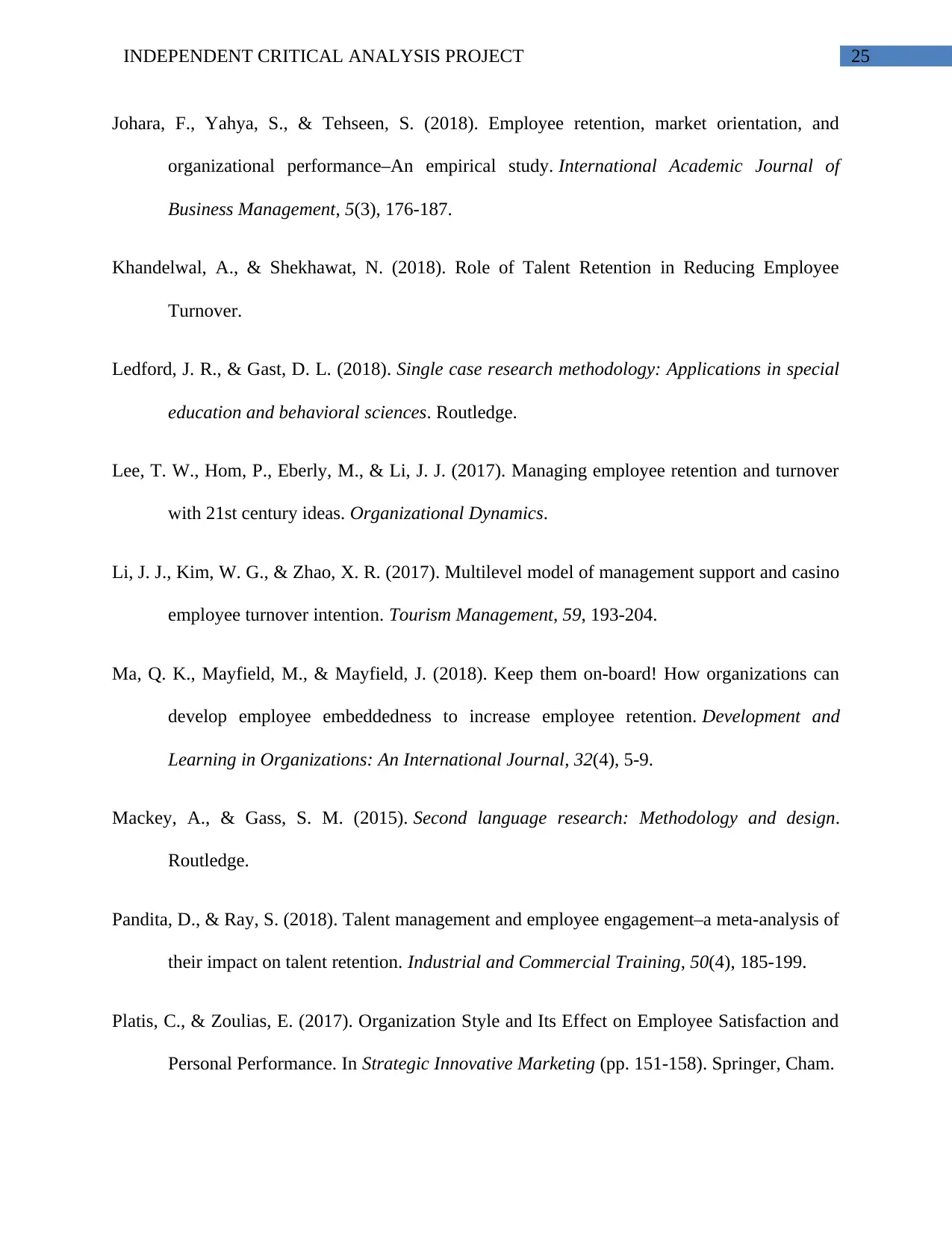
25INDEPENDENT CRITICAL ANALYSIS PROJECT
Johara, F., Yahya, S., & Tehseen, S. (2018). Employee retention, market orientation, and
organizational performance–An empirical study. International Academic Journal of
Business Management, 5(3), 176-187.
Khandelwal, A., & Shekhawat, N. (2018). Role of Talent Retention in Reducing Employee
Turnover.
Ledford, J. R., & Gast, D. L. (2018). Single case research methodology: Applications in special
education and behavioral sciences. Routledge.
Lee, T. W., Hom, P., Eberly, M., & Li, J. J. (2017). Managing employee retention and turnover
with 21st century ideas. Organizational Dynamics.
Li, J. J., Kim, W. G., & Zhao, X. R. (2017). Multilevel model of management support and casino
employee turnover intention. Tourism Management, 59, 193-204.
Ma, Q. K., Mayfield, M., & Mayfield, J. (2018). Keep them on-board! How organizations can
develop employee embeddedness to increase employee retention. Development and
Learning in Organizations: An International Journal, 32(4), 5-9.
Mackey, A., & Gass, S. M. (2015). Second language research: Methodology and design.
Routledge.
Pandita, D., & Ray, S. (2018). Talent management and employee engagement–a meta-analysis of
their impact on talent retention. Industrial and Commercial Training, 50(4), 185-199.
Platis, C., & Zoulias, E. (2017). Organization Style and Its Effect on Employee Satisfaction and
Personal Performance. In Strategic Innovative Marketing (pp. 151-158). Springer, Cham.
Johara, F., Yahya, S., & Tehseen, S. (2018). Employee retention, market orientation, and
organizational performance–An empirical study. International Academic Journal of
Business Management, 5(3), 176-187.
Khandelwal, A., & Shekhawat, N. (2018). Role of Talent Retention in Reducing Employee
Turnover.
Ledford, J. R., & Gast, D. L. (2018). Single case research methodology: Applications in special
education and behavioral sciences. Routledge.
Lee, T. W., Hom, P., Eberly, M., & Li, J. J. (2017). Managing employee retention and turnover
with 21st century ideas. Organizational Dynamics.
Li, J. J., Kim, W. G., & Zhao, X. R. (2017). Multilevel model of management support and casino
employee turnover intention. Tourism Management, 59, 193-204.
Ma, Q. K., Mayfield, M., & Mayfield, J. (2018). Keep them on-board! How organizations can
develop employee embeddedness to increase employee retention. Development and
Learning in Organizations: An International Journal, 32(4), 5-9.
Mackey, A., & Gass, S. M. (2015). Second language research: Methodology and design.
Routledge.
Pandita, D., & Ray, S. (2018). Talent management and employee engagement–a meta-analysis of
their impact on talent retention. Industrial and Commercial Training, 50(4), 185-199.
Platis, C., & Zoulias, E. (2017). Organization Style and Its Effect on Employee Satisfaction and
Personal Performance. In Strategic Innovative Marketing (pp. 151-158). Springer, Cham.
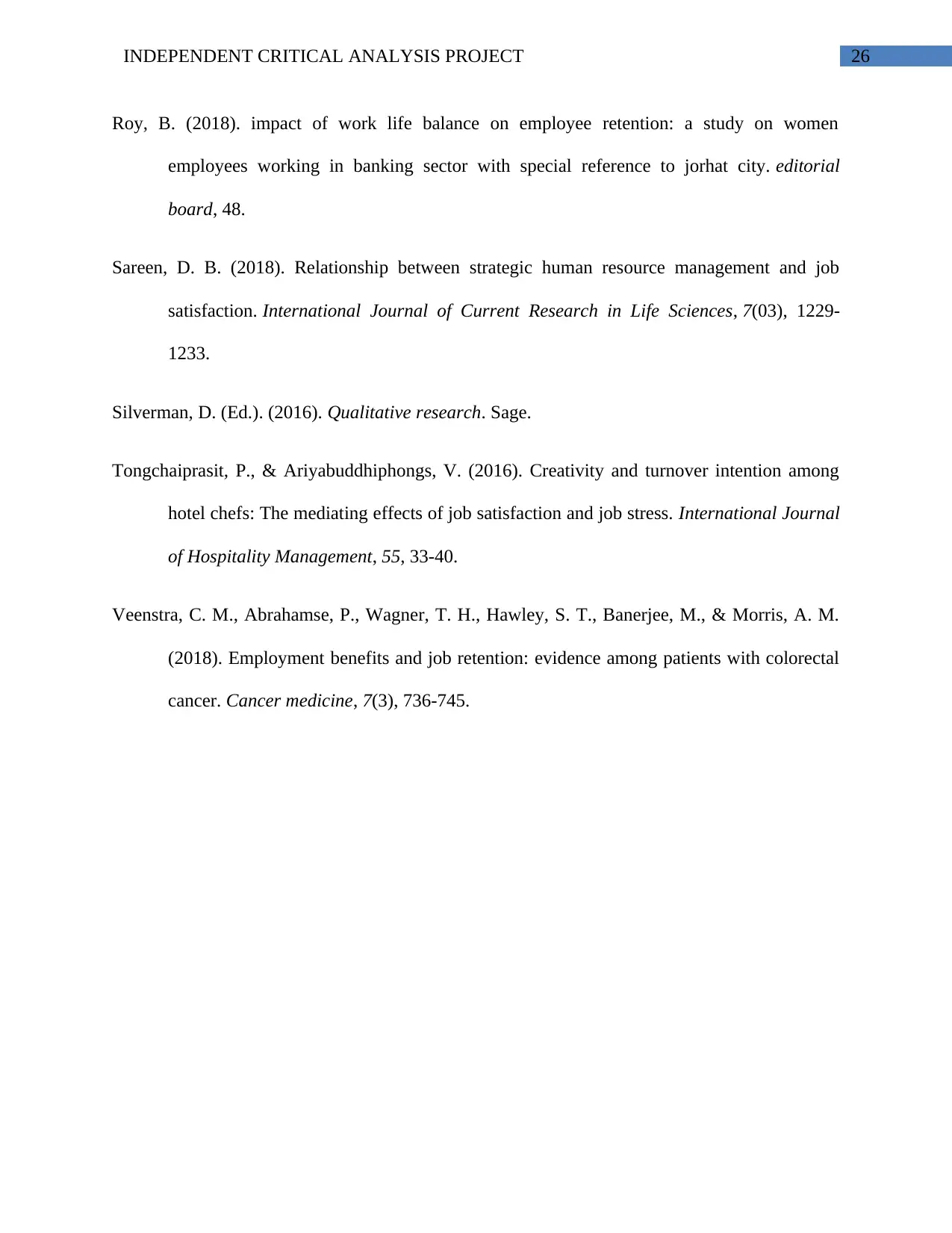
26INDEPENDENT CRITICAL ANALYSIS PROJECT
Roy, B. (2018). impact of work life balance on employee retention: a study on women
employees working in banking sector with special reference to jorhat city. editorial
board, 48.
Sareen, D. B. (2018). Relationship between strategic human resource management and job
satisfaction. International Journal of Current Research in Life Sciences, 7(03), 1229-
1233.
Silverman, D. (Ed.). (2016). Qualitative research. Sage.
Tongchaiprasit, P., & Ariyabuddhiphongs, V. (2016). Creativity and turnover intention among
hotel chefs: The mediating effects of job satisfaction and job stress. International Journal
of Hospitality Management, 55, 33-40.
Veenstra, C. M., Abrahamse, P., Wagner, T. H., Hawley, S. T., Banerjee, M., & Morris, A. M.
(2018). Employment benefits and job retention: evidence among patients with colorectal
cancer. Cancer medicine, 7(3), 736-745.
Roy, B. (2018). impact of work life balance on employee retention: a study on women
employees working in banking sector with special reference to jorhat city. editorial
board, 48.
Sareen, D. B. (2018). Relationship between strategic human resource management and job
satisfaction. International Journal of Current Research in Life Sciences, 7(03), 1229-
1233.
Silverman, D. (Ed.). (2016). Qualitative research. Sage.
Tongchaiprasit, P., & Ariyabuddhiphongs, V. (2016). Creativity and turnover intention among
hotel chefs: The mediating effects of job satisfaction and job stress. International Journal
of Hospitality Management, 55, 33-40.
Veenstra, C. M., Abrahamse, P., Wagner, T. H., Hawley, S. T., Banerjee, M., & Morris, A. M.
(2018). Employment benefits and job retention: evidence among patients with colorectal
cancer. Cancer medicine, 7(3), 736-745.
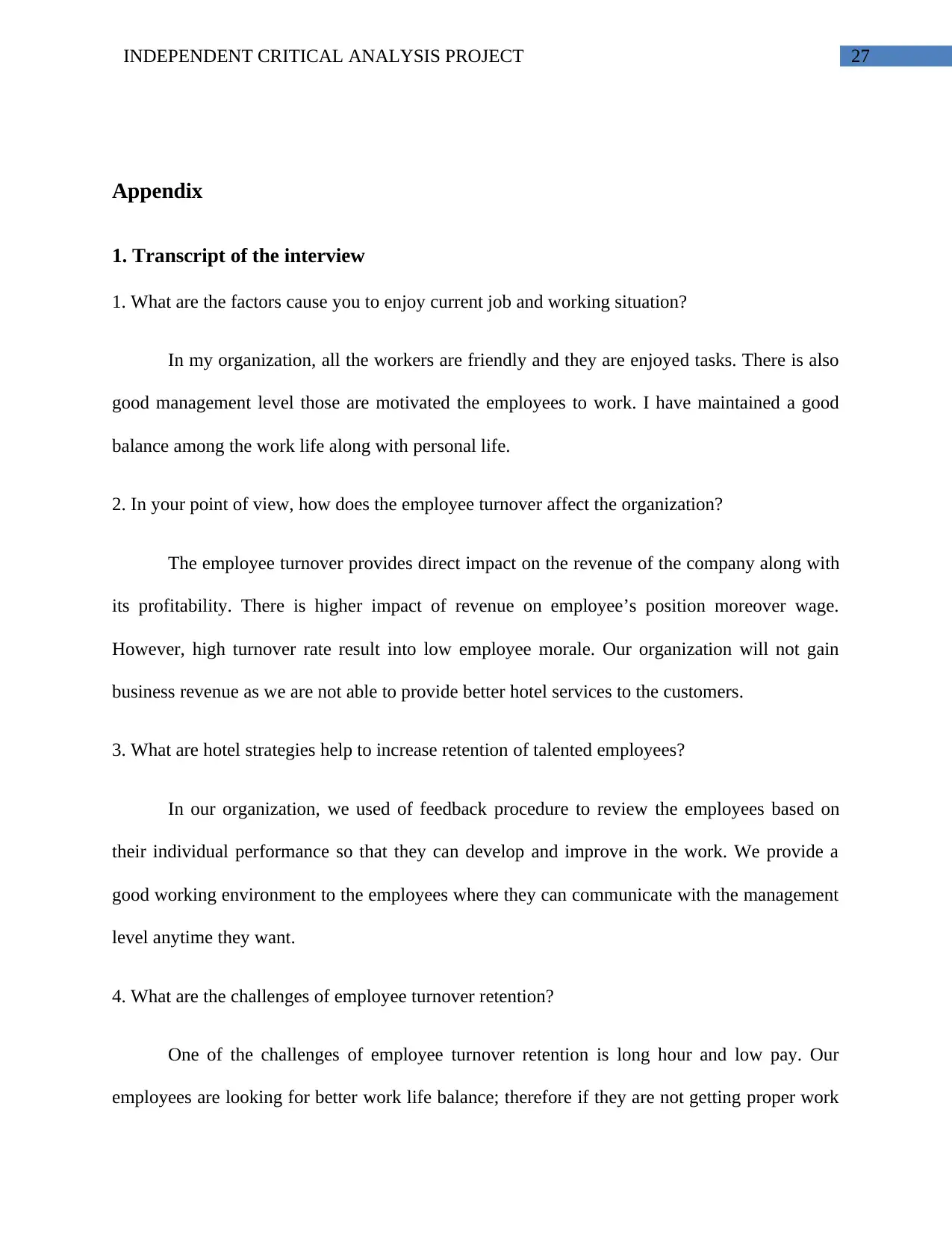
27INDEPENDENT CRITICAL ANALYSIS PROJECT
Appendix
1. Transcript of the interview
1. What are the factors cause you to enjoy current job and working situation?
In my organization, all the workers are friendly and they are enjoyed tasks. There is also
good management level those are motivated the employees to work. I have maintained a good
balance among the work life along with personal life.
2. In your point of view, how does the employee turnover affect the organization?
The employee turnover provides direct impact on the revenue of the company along with
its profitability. There is higher impact of revenue on employee’s position moreover wage.
However, high turnover rate result into low employee morale. Our organization will not gain
business revenue as we are not able to provide better hotel services to the customers.
3. What are hotel strategies help to increase retention of talented employees?
In our organization, we used of feedback procedure to review the employees based on
their individual performance so that they can develop and improve in the work. We provide a
good working environment to the employees where they can communicate with the management
level anytime they want.
4. What are the challenges of employee turnover retention?
One of the challenges of employee turnover retention is long hour and low pay. Our
employees are looking for better work life balance; therefore if they are not getting proper work
Appendix
1. Transcript of the interview
1. What are the factors cause you to enjoy current job and working situation?
In my organization, all the workers are friendly and they are enjoyed tasks. There is also
good management level those are motivated the employees to work. I have maintained a good
balance among the work life along with personal life.
2. In your point of view, how does the employee turnover affect the organization?
The employee turnover provides direct impact on the revenue of the company along with
its profitability. There is higher impact of revenue on employee’s position moreover wage.
However, high turnover rate result into low employee morale. Our organization will not gain
business revenue as we are not able to provide better hotel services to the customers.
3. What are hotel strategies help to increase retention of talented employees?
In our organization, we used of feedback procedure to review the employees based on
their individual performance so that they can develop and improve in the work. We provide a
good working environment to the employees where they can communicate with the management
level anytime they want.
4. What are the challenges of employee turnover retention?
One of the challenges of employee turnover retention is long hour and low pay. Our
employees are looking for better work life balance; therefore if they are not getting proper work
Secure Best Marks with AI Grader
Need help grading? Try our AI Grader for instant feedback on your assignments.
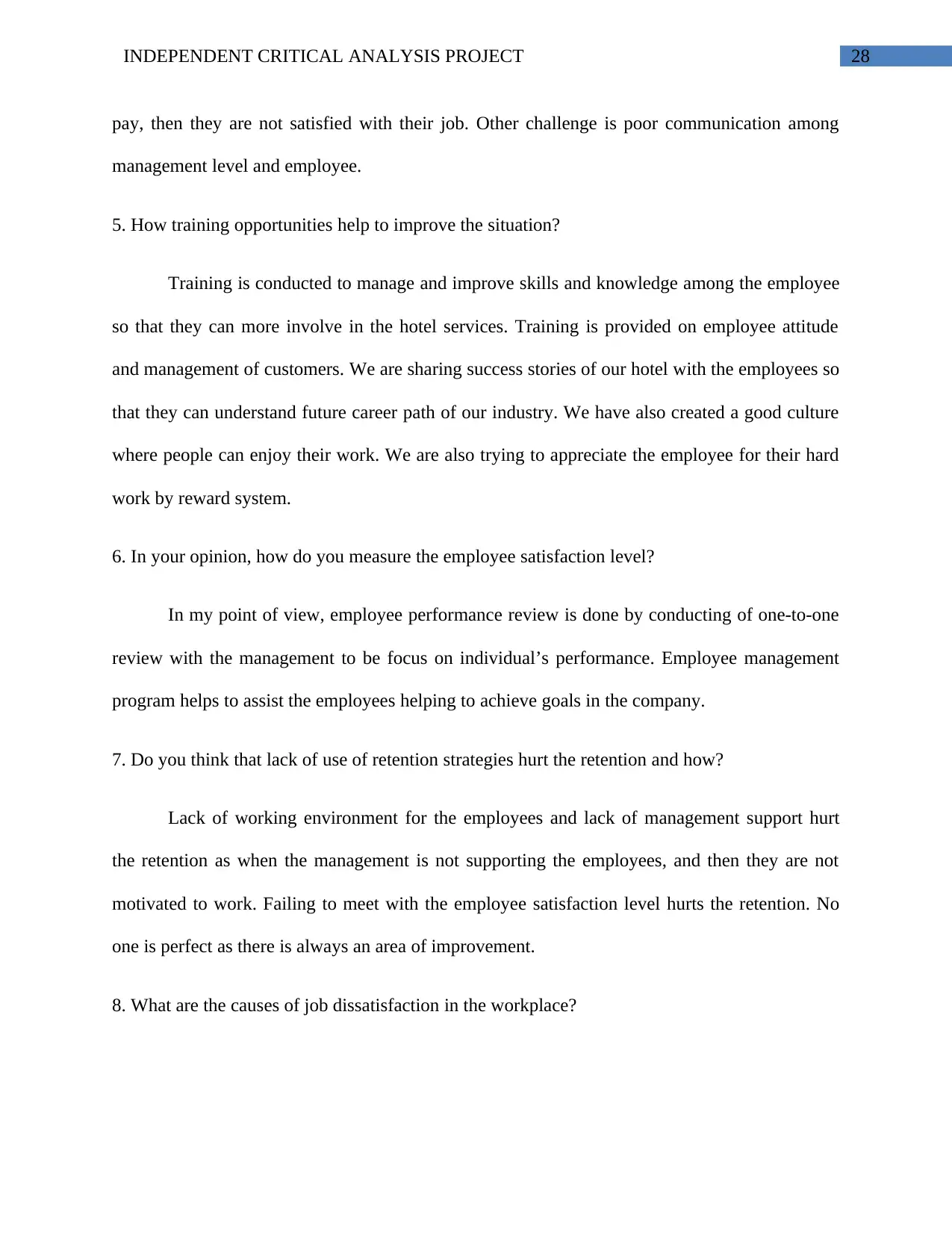
28INDEPENDENT CRITICAL ANALYSIS PROJECT
pay, then they are not satisfied with their job. Other challenge is poor communication among
management level and employee.
5. How training opportunities help to improve the situation?
Training is conducted to manage and improve skills and knowledge among the employee
so that they can more involve in the hotel services. Training is provided on employee attitude
and management of customers. We are sharing success stories of our hotel with the employees so
that they can understand future career path of our industry. We have also created a good culture
where people can enjoy their work. We are also trying to appreciate the employee for their hard
work by reward system.
6. In your opinion, how do you measure the employee satisfaction level?
In my point of view, employee performance review is done by conducting of one-to-one
review with the management to be focus on individual’s performance. Employee management
program helps to assist the employees helping to achieve goals in the company.
7. Do you think that lack of use of retention strategies hurt the retention and how?
Lack of working environment for the employees and lack of management support hurt
the retention as when the management is not supporting the employees, and then they are not
motivated to work. Failing to meet with the employee satisfaction level hurts the retention. No
one is perfect as there is always an area of improvement.
8. What are the causes of job dissatisfaction in the workplace?
pay, then they are not satisfied with their job. Other challenge is poor communication among
management level and employee.
5. How training opportunities help to improve the situation?
Training is conducted to manage and improve skills and knowledge among the employee
so that they can more involve in the hotel services. Training is provided on employee attitude
and management of customers. We are sharing success stories of our hotel with the employees so
that they can understand future career path of our industry. We have also created a good culture
where people can enjoy their work. We are also trying to appreciate the employee for their hard
work by reward system.
6. In your opinion, how do you measure the employee satisfaction level?
In my point of view, employee performance review is done by conducting of one-to-one
review with the management to be focus on individual’s performance. Employee management
program helps to assist the employees helping to achieve goals in the company.
7. Do you think that lack of use of retention strategies hurt the retention and how?
Lack of working environment for the employees and lack of management support hurt
the retention as when the management is not supporting the employees, and then they are not
motivated to work. Failing to meet with the employee satisfaction level hurts the retention. No
one is perfect as there is always an area of improvement.
8. What are the causes of job dissatisfaction in the workplace?
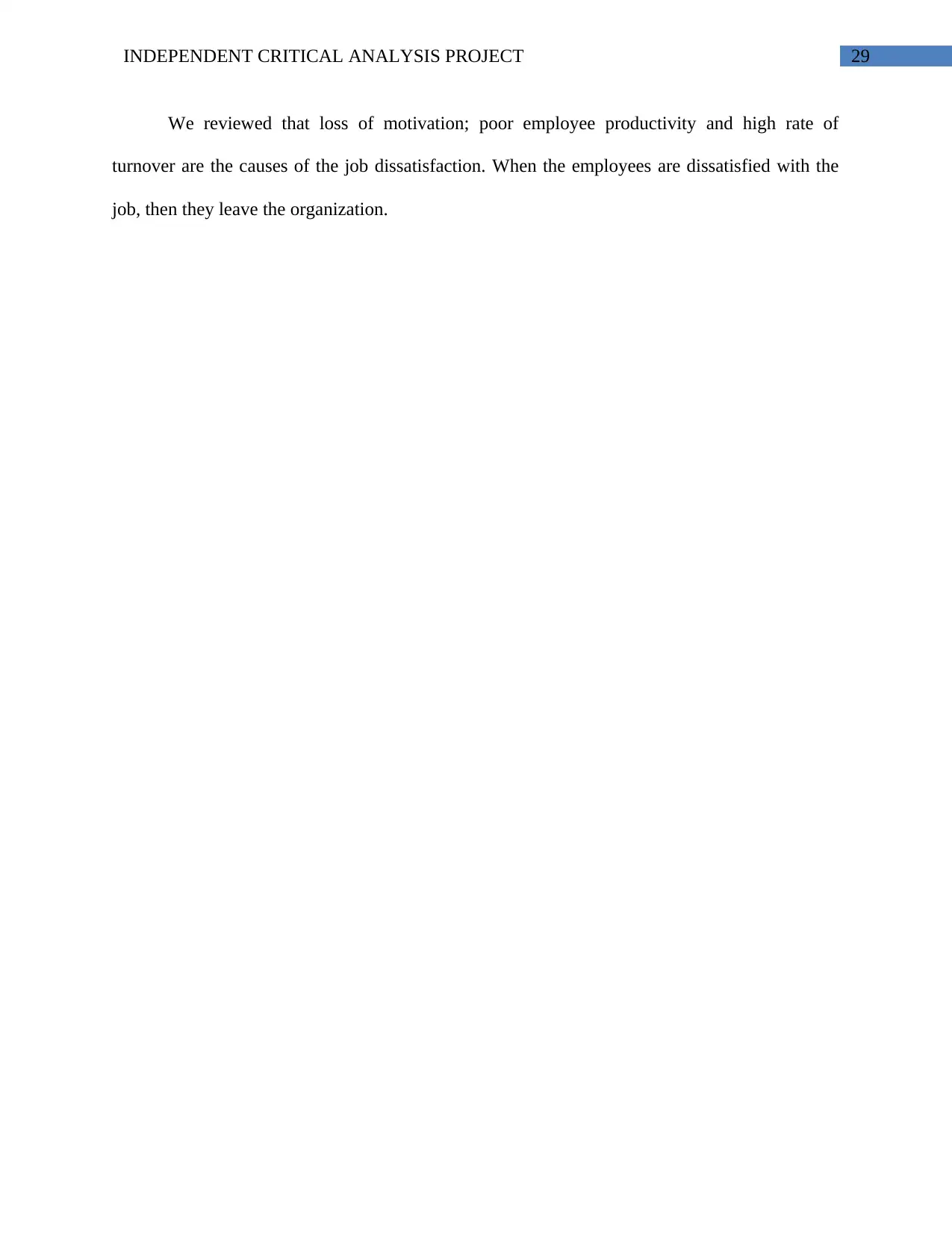
29INDEPENDENT CRITICAL ANALYSIS PROJECT
We reviewed that loss of motivation; poor employee productivity and high rate of
turnover are the causes of the job dissatisfaction. When the employees are dissatisfied with the
job, then they leave the organization.
We reviewed that loss of motivation; poor employee productivity and high rate of
turnover are the causes of the job dissatisfaction. When the employees are dissatisfied with the
job, then they leave the organization.
1 out of 30
Related Documents
Your All-in-One AI-Powered Toolkit for Academic Success.
+13062052269
info@desklib.com
Available 24*7 on WhatsApp / Email
![[object Object]](/_next/static/media/star-bottom.7253800d.svg)
Unlock your academic potential
© 2024 | Zucol Services PVT LTD | All rights reserved.





